A Guide to the Common Locoweeds and Milkvetches of New Mexico
Circular 557
William E. Fox, III, Kelly W. Allred, Eric H. Roalson
College of Agricultural, Consumer and Environmental Sciences, New Mexico State University
Authors: Respectively, former graduate student, Professor, and former graduate student, all of the Department of Animal and Range Sciences, New Mexico State University. (Print Friendly PDF)
Introduction
Estimates indicate that annual losses of livestock due to poisonous plants in the 17 Western states may reach as much as $339 million (Nielsen and James, 1992). A major cause of these poisonings is the plants commonly referred to as locoweeds or milkvetches, members of the plant genera Astragalus and Oxytropis in the pea family. “Loco” in Spanish means “crazy” and alludes to the often disoriented behavior of animals afflicted by these plants.
There are 373 species of Astragalus and 22 species of Oxytropis in the United States (Barneby, 1952, 1964). Of these, approximately 75 Astragalus and five Oxytropis species are known from the state of New Mexico. This guide treats 19 of the most common species of Astragalus and Oxytropis in New Mexico, including some 35 different varieties. The species chosen were considered to be the most abundant in the state and the most likely to be encountered, whether toxic or not. They are:
Astragalus agrestis Dougl. ex Hook.
Astragalus allochrous A. Gray
Astragalus amphioxys A. Gray
Astragalus bisulcatus (Hook.) Gray
Astragalus ceramicus E. Sheldon
Astragalus crassicarpus Nutt.
Astragalus drummondii Dougl. ex Hook.
Astragalus emoryanus (Rydb.) Cory
Astragalus humistratus Gray
Astragalus lentiginosus Dougl. ex Hook.
Astragalus lonchocarpus Torr.
Astragalus missouriensis Nutt.
Astragalus mollissimus Torr.
Astragalus nuttallianus DC.
Astragalus praelongus Sheldon
Astragalus racemosus Pursh
Astragalus tephrodes Gray
Oxytropis lambertii Pursh
Oxytropis sericea Nutt. ex T. & G.
Each species treatment contains information about nomenclature, identification and description, distribution and habitat, and toxic compounds, as well as illustrations and distribution maps. Geographic distributions were mapped using localities from the herbaria at New Mexico State University and the University of New Mexico, with some additions from Barneby (1964).
Toxicology
Toxic plants of Astragalus and Oxytropis contain one or more of three toxic principles and may be classed into three groups: 1) “true locoweeds” of the genera Astragalus and Oxytropis, which contain swainsonine, an indolizidine alkaloid; 2) Astragalus species that contain aliphatic nitro-compounds; and 3) Astragalus species that accumulate selenium in toxic proportions. Those plants containing swainsonine are more correctly referred to as locoweeds, whereas the other poisonous members of these genera (as well as the non-toxic species) may be called milkvetches. New Mexico species of Astragalus and Oxytropis that have definitely been reported as toxic are listed in Table 1.
| Table 1. Toxins Found in Species of Astragalus and Oxytropis in New Mexico | |
| Taxon | Reference |
| Swainsonine | |
| A. allochrous A. Gray | Allison 1984; Allred 1991a, b; Smith et al. 1992. |
|
|
|
Allred 1991a, b. |
| A. bisulcatus (Hook.) Gray | Cheeke and Shull 1985; Kingsbury 1964; Smith et al. 1992. |
|
|
| A. drummondii Dougl. ex Hook. | This work, Table 2. |
| A. emoryanus (Rydb.) Cory | Davis et al. 1984. |
| A. lentiginosus Dougl. ex Hook. | Cheeke and Shull 1985; Hartley et al.1989; James et al. 1981; Kingsbury 1964; Panter et al. 1992. |
|
|
| A. lonchocarpus Torr. | Smith et al. 1992. |
| A. missouriensis Nutt. | Smith et al. 1992. |
|
|
| A. mollissimus Torr. | Allison 1984; Cheeke and Shull 1985; James et al. 1981; Kingsbury 1964; Smith et al. 1992. |
|
|
|
|
| A. praelongus Sheld. | Smith et al. 1992. |
| A. tephrodes | This work, Table 2. |
| O. lambertii Pursh | Allison 1984; Cheeke and Shull 1985; Kingsbury 1964; Smith et al. 1992. |
| O. sericea Nutt. ex T. & G. | Allison 1984; Allred 1991a; Cheeke and Shull 1985; James 1983; Kingsbury 1964; Williams and James 1976. |
| Nitro-Compounds | |
| A. emoryanus (Rydb.) Cory | Allison 1984; James 1983; Kingsbury 1964; Williams and James 1976. |
| Selenium | |
| A. bisulcatus (Hook.) Gray |
Cheeke and Shull 1985; James, Panter and Molyneux 1992; Kingsbury 1964. |
|
|
|
|
| A. praelongus Sheld. | James et al. 1981; Williams and Olsen 1992. |
|
|
|
|
| A. racemosus Pursh | Cheeke and Shull 1985. |
|
|
|
|
Swainsonine
The exact nature of the toxic principle in true locoweeds was unknown until 1982, when Molyneux and James (1982) isolated an indolizidine alkaloid known as swainsonine from Astragalus lentiginosus. Swainsonine inhibits a-mannosidases, which are key enzymes responsible for the primary steps in processing and degrading glycoproteins (James et al., 1989). Swainsonine causes a wide variety of toxicological problems, including neurological, cardiovascular, and reproductive effects; emaciation; and habituation (James et al., 1981). There are no treatments for livestock poisoned by swainsonine-containing locoweeds. Depending on its extent, the damage done by swainsonine poisoning may be permanent. The organs and tissues affected by swainsonine include the thyroid acinar epithelium, pancreatic exocrine glandular epithelium, choroid plexus epithelium, renal proximal convoluted tubular epithelium, and nerve cell bodies of the central and peripheral nervous systems (Hartley et al., 1989). The amount of swainsonine within the plants has been shown to vary 10 to 100 fold among species and within species (Smith et al., 1992). Table 2 documents the variation in swainsonine content in several species of New Mexico locoweeds. Unfortunately, swainsonine content alone does not predict the toxicity of locoweeds, but a method of measuring enzymatic inhibition has been developed that determines the toxic activity of the swainsonine (Smith et al., 1992).
| Table 2. Swainsonine Content of Selected Astragalus and Oxytropis Species Collected in New Mexicoa | ||||
| Plant Species | Growth Stage | County | Date of Collection |
Swainsonine Content (mg/g dry matterb) |
| A. allochrous | ||||
|
Seed Set | Luna | 6/91d | 2.53 ± 0.11 |
| 4.78 ± 0.44 | ||||
| 5.49 ± 0.27 | ||||
| Bloom | Doña Ana | 1989c | 6.25 ± 0.34 | |
| 7.51 ± 0.59 | ||||
| Seed Set | 7.53 ± 0.45 | |||
| 9.46 ± 1.28 | ||||
|
Bloom | Grant | 5/85d | 11.50 ± 1.15 |
| Bloom | 1991d | 0.71 ± 0.05 | ||
| A. bisulcatus | ||||
|
Seed Set | Colfax | 5/91d | 0.36 ± 0.04 |
| 0.28 ± 0.02 | ||||
| 0.28 ± 0.00 | ||||
| Harding | 0.15 ± 0.01 | |||
| Union | 6/92e | < 0.0002 | ||
|
Bloom | McKinley | 5/92e | 0.006 ± 0.00 |
| A. drummondii | Bloom | Rio Arriba | 6/91e | 0.60 ± 0.05 |
| A. lonchocarpus | Bloom | Rio Arriba | 5/91d | 0.39 ± 0.02 |
| 0.26 ± 0.02 | ||||
| 0.06 ± 0.02 | ||||
| Colfax | 0.11 ± 0.00 | |||
| Sandoval | 5/85d | 4.37 ± 0.04 | ||
| A. missouriensis | ||||
|
Prebloom | Otero | 5/91d | 0.12 ± 0.01 |
| San Miguel | 0.18 ± 0.01 | |||
| A. mollissimus | ||||
|
Bloom | Sierra | 4/92e | 0.486 ± 0.00 |
| 0.326 ± 0.00 | ||||
| 0.035 ± 0.004 | ||||
|
Bloom | Otero | 6/91d | 0.80 ± 0.03 |
| Sierra | 4/91d | 0.34 ± 0.02 | ||
| Seed Set | Union | 1989c | 10.31 ± 0.34 | |
| A. nuttallianus | Prebloom | Otero | 4/92e | < 0.0002 |
| Bloom | Otero | 5/92e | < 0.0002 | |
| Seed Set | Otero | 10/91d | < 0.0002 | |
| < 0.0002 | ||||
| < 0.0002 | ||||
| A. praelongus | Bloom | Colfax | 5/91d | 0.16 ± 0.01 |
| Harding | 0.03 ± 0.01 | |||
| Colfax | 0.08 ± 0.00 | |||
| Sierra | 0.17 ± 0.01 | |||
| A. tephrodes | Bloom | Doña Ana | 5/92e | 0.032 ± 0.00 |
| Grant | < 0.0002 | |||
| A. thurberi | Seed Set | Grant | 5/92e | 3.37 ± 0.32 |
| O. lambertii | Prebloom | Sierra | 1987c | 0.99 ± 0.06 |
| Bloom | Mora | 5/91d | 0.26 ± 0.00 | |
| Sierra | 0.21 ± 0.00 | |||
| O. sericea | Bloom | Union | 9/91d | 0.43 ± 0.00 |
| Harding | 5/91d | 1.18 ± 0.01 | ||
| Colfax | 0.53 ± 0.06 | |||
| Rio Arriba | 0.05 ± 0.00 | |||
| aDetermined by the Toxicology Laboratory, Department of Animal and Range Sciences, New Mexico State University. bDetermined by gas chromatography; values are mean ± SD, based on duplicate analyses. cReported earlier by Miller, Smith and Kiehl (1989). dReported earlier by Allred (1991b). eDetermined in this study. |
||||
Neurological Effects
Neurological effects of swainsonine toxicity range from disorientation to permanent nervous system damage and possibly death. Animals affected by swainsonine lose the ability to function correctly. They become excited when stressed, are inattentive to their surroundings (run into objects), lose muscular coordination, and become depressed. The clinical sign of poisoning is severe cytoplasmic foamy vacuolation. This usually coincides with the gradual appearance of focal axonal swelling in the white matter of the central nervous system, especially in the cerebellum, and particularly around the nerve cell bodies of the root nuclei (Hartley et al., 1989).
Cardiovascular Effects
Cattle, particularly calves, grazing on high-altitude ranges (7,000–9,800 ft, 2100–3000 m) infested with Oxytropis sericea have a greater occurrence of congestive heart failure than normal (James et al., 1983). This occurrence has been called high mountain disease.
The symptoms of high mountain disease include weakness, depression, reluctance to move, unthriftiness, visible jugular pulse, labored respiration, and profuse, dark-fluid diarrhea. Swelling in the jaw, brisket, and ventral abdominal wall also are common. Forced exertion may cause the animal to collapse and die. It has been demonstrated that calves nursing from cows that have grazed locoweeds at high elevations also have developed high mountain disease (James et al., 1986). Calves developing congestive heart failure after eating locoweeds do not always show the characteristic symptoms of locoweed poisoning, but exhibit dry nose, rough dry coat, dull-appearing eyes, depression, swelling of the jaw and brisket, and dark-fluid diarrhea. Some calves develop swelling and then seem to become dehydrated (James, 1983). In some years, the estimated frequency of congestive heart failure from locoweeds approaches 100%, with 10 to 15% mortality (James et al., 1986).
Reproductive Effects
Swainsonine may also cause a drastic reduction in the reproductive efficiency of livestock. Intoxication may affect sperm, egg, embryo, and fetal development, and cause abortion.
Sperm and egg development are inhibited in sheep (and presumably other species of livestock) that have grazed locoweeds over a period of weeks (James and Van Kampen, 1971). Declines occur in libido, fertilization, and placentation when locoweeds are fed at 0 to 50 days of gestation in sheep.
Swainsonine also affects embryonic and fetal development. Ingesting locoweed may cause a drop in fetal heart rates, changes in placental function, fetal swelling, fetal death, and abortion at various levels in pregnant ewes (Panter et al., 1987). Unlike other abortion-inducing plants such as ponderosa pine and broom snakeweed, locoweeds can cause abortion at any time during the pregnancy. Also, dams that graze locoweeds may produce small, weak offspring (James et al., 1992b).
Habituation
It is commonly thought that swainsonine intoxication is addictive or causes habituation. The term habituation refers to a response acquired by repeated use. It is often difficult to distinguish between true habituation or addiction and repeated use of a forage because of high palatability or forage choice. The evidence has not shown conclusively that livestock become addicted, in the clinical sense, to locoweeds (Ralphs and Molyneux, 1989), though experience seems to indicate a decided preference by some animals.
Nitro-Containing Astragalus
About 263 species of Astragalus from throughout North America contain aliphatic nitro compounds toxic to livestock (Cheeke and Shull, 1985). However, the number of known Astragalus species in New Mexico that produce toxic nitro compounds is apparently very low (Table 1), and only Astragalus emoryanus consistently causes problems with nitrate toxicity (Williams et al., 1979). These plants synthesize glycosides that are metabolized to 3-nitro-1-propanol (3-NPOH) or 3-nitro-1-propionic acid (3-NPA) in the rumen of cattle and sheep (James, 1983). Of the two molecules, the 3-NPOH is absorbed more quickly in the gastrointestinal tract and is therefore more toxic. Ruminants are more susceptible to these compounds due to the rumen’s ability to convert 3-NPA into the more toxic 3-NPOH.
Poisoning in cattle and sheep occurs in either acute or chronic forms depending on the rate at which the plants are grazed. Acute poisoning occurs when a large amount of the toxin is ingested quickly by the livestock. Symptoms include general body weakness, labored noisy breathing, and loss of motor control, especially in the hindquarters. Severely poisoned animals may collapse and die shortly after consuming the plants.
Chronic poisoning is more common than acute poisoning and occurs when animals ingest smaller amounts of the toxin over a long period of time. Signs of chronic poisoning include rough hair coat, labored breathing, knuckling of the fetlocks, goose-stepping, knocking of the hind feet, and general body weakness beginning in the hindquarters. Animals may salivate excessively and develop diarrhea or constipation. When forced to exert themselves, they may collapse and die. Lactating cows are more commonly affected than those that are not. Livestock may recover if removed from the source of the poisoning during the early stages (James, 1983).
There are no known treatments for animals poisoned by these toxins. The best prevention is to limit the time cattle are exposed to the plants.
Selenium Accumulators
About 24 species of Astragalus are known to accumulate selenium in toxic levels (James et al., 1981). Some of the more notable species are Astragalus bisulcatus (two-grooved milkvetch), A. praelongus (stinking milkvetch), and A. racemosus (alkali milkvetch). These plants can accumulate selenium at concentrations up to several parts per million.
There are two types of selenium poisoning: acute and chronic. Acute poisoning occurs when animals ingest, in a short period of time, forage containing high quantities of selenium. This usually occurs only when the animals are hungry because selenium-containing plants are generally unpalatable. Characteristic symptoms in cattle, horses, and swine include abnormal posture, unsteady gait, diarrhea, abdominal pain, increased respiration and pulse, prostration, and death. Sheep do not show these symptoms as clearly as other livestock, but become lethargic and then suddenly die (James et al., 1992a).
Chronic selenium poisoning occurs in two syndromes: the so-called alkali disease and blind staggers. Characteristic symptoms of alkali disease include decreased vitality, emaciation, rough hair coat, loss of hair, overgrown hooves, and lameness. Sheep do not develop the typical signs of poisoning, but instead show decreased reproductive performance (Olsen, 1978). This lowered reproductive performance occurs at lower selenium levels than those required to cause alkali disease in other animals (James et al., 1992a).
Traditionally, blind staggers was thought to result from ingesting selenium-containing plants, although this has currently come into question. In cattle, symptoms occur in three stages. Stage 1 includes impaired vision, disregard of objects in the animal’s path, and early signs of anorexia. In stage 2, the animal begins to show signs of general body weakness and becomes anorexic. In stage 3, the animal loses eyesight, shows rapid labored respiration, and experiences paralysis of tongue and the swallowing process, followed by death. In sheep, the symptoms may be much less pronounced, but the results are the same (James et al., 1992a).
Management
Many poisonous plants are weedy and not part of the naturally occurring native plant community, but in the case of Astragalus and Oxytropis this does not hold true. These plants occur naturally on rangelands, and they may be present in pastures in good to excellent condition.
Toxic range plants cost ranchers money through increased deaths, reduced weight gains and reproductive efficiency, added management costs, control costs, reductions in land values and value of livestock, restricted land and livestock uses, and loss of usable forage due to direct competition from these plants (Nielsen, 1988). Two ways to decrease these losses are through proper grazing management and chemical control of the poisonous plants.
Grazing Management
The most effective method to reduce livestock losses from poisonous plants is to ensure that palatable and nutritious forage is available to livestock (Krueger and Sharp, 1978). On the open, semiarid rangelands of the West this is not always possible because forage is not always available. Therefore, management-intensive approaches must be used.
Locoweeds are often green during the early part of the spring, before the grasses and other forages have begun to grow. Locoweeds present a serious danger at this time because livestock tend to graze green plant material over dry material (James et al., 1968). Livestock native to locoweed-infested areas are perhaps less likely to consume the plants, but all livestock should be watched carefully (Patterson, 1982).
Grazing management is based mainly on stocking rates, livestock species grazing the area, and the grazing system employed by the manager. Of these three management decisions, stocking rate may have the greatest influence on vegetation and livestock productivity (Taylor and Ralphs, 1992). Moderate stocking rates result in better rangeland conditions (Holechek et al., 1989; Kothmann et al., 1975; Martin and Ward, 1976).
The following suggestions may help to reduce the incidence of locoweed poisoning.
- Avoid heavy grazing and other disturbances that may remove or reduce perennial vegetation.
- Develop grazing practices that improve the condition of the range.
- Reduce grazing pressure during periods of drought.
- Avoid grazing areas in early spring when locoweeds are the primary green plants available to livestock.
- Watch livestock and what they are grazing, and know what is available for grazing in the pasture.
- Do not place diseased, malnourished, or recently transported livestock on rangeland infested with locoweeds.
If the rangeland is still in at least fair condition, good grazing practices should return the land to a point where poisonous plants do not present hazards to livestock (Krueger and Sharp, 1978). If infestation has proceeded too far and a large portion of the land is overrun by poisonous plants, it may become economical to consider overall improvements of the land (Krueger and Sharp, 1978).
Chemical Control
Before the introduction of phenoxy herbicides, grubbing was the most common and effective method for controlling toxic plants on the range (Marsh, 1909; Marsh and Clawson, 1936). Mowing also was recommended to prevent perennial species from producing seeds (Ralphs and Ueckert, 1988). These methods approached control as a short-term solution, reducing the present year’s growth only. Methods changed radically with the implementation of chemicals that controlled the growth of target plants.
The introduction of phenoxy herbicides in the early 1950s allowed ranchers to manage poisonous plants on a long-term basis. Controlling locoweeds was variable in the early years. The control of white locoweed (Oxytropis sericea) using 2,4-D in Montana and Wyoming varied from high to inconsistent (Bohmont, 1952; Payne and Warden, 1952).
With the development of more efficient herbicides, controlling locoweeds became more effective. Clopyralid, picloram, dicamba, and 2,4-D LVE have been shown to control locoweeds at a rate of 90% or higher (McDaniel, 1993). Table 3 offers suggestions of herbicides labeled for locoweed control.
| Table 3. Herbicides Labeled for Locoweed Control (Ralphs and Ueckert, 1988) | |||
| Type | Herbicide | Trade Namea | Rate (lb ai/acre) |
| Foliar sprayb | Picloram | Tordon 22K | 0.375–0.5 |
| Picloram + 2,4-D | Grazon P+D | 0.625–1.0 | |
| Dicamba | Banvel | 1.0 | |
| Dicamba + 2,4-D | Weedmaster | 2.0 | |
| 2,4-D ester | Esteron 99 and others | 2.0–4.0 | |
| Clopyralid | Reclaim | 0.25 | |
|
a This information is given for educational purposes only. Brand names appearing in publications are for product identification purposes only. No endorsement is intended, nor is criticism implied of similar products not mentioned. Persons using such products assume responsibility for their use in accordance with current label directions of the manufacturer. bApply prior to flowering, during vegetative growth stage. |
|||
When the proper herbicides are applied during optimum growing conditions, control of a majority of Astragalus and Oxytropis species can be achieved (Ralphs and Ueckert, 1988). However, complete eradication of the plants is not probable. Locoweed seed banks range from 400 to 4,300 seeds/m2 in infested areas (Ralphs and Cronin, 1987). Given this amount of seeds in the soil, complete eradication is probably not a realistic goal on heavily infested rangelands.
Identification
Identifying a particular locoweed or milkvetch may be accomplished by using the written key in this guide. It should be noted that the identification aids work only for the 19 common species that are treated in this guide.
An understanding of the general structure of a locoweed plant will be helpful in identification. The leaves are compound, that is, divided into leaflets (Figure 1). At the base of the leaf stalk, where it joins the stem, are small scale-like structures called stipules, which may be united around the stem (Figure 2) or free from each other (Figure 3). The flowers are arranged in an inflorescence called a raceme (Figure 4). Each flower is composed of three specialized kinds of petals: the banner, wings, and keel (Figures 5 and 6). Pods (Figure 7) are the fruiting structures, which contain the seeds. They are important in proper identification. Each pod either has a single chamber or is divided by a cross-wall into two chambers. More technical terms that may be used in the descriptions are defined in the glossary.

Fig. 1: Leaflet

Fig. 2: Stipules united

Fig. 3: Stipules free

Fig. 4: Raceme
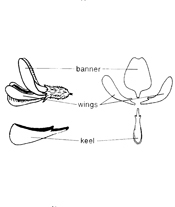
Fig. 5 and Fig. 6: Kinds of petals the banner, wings, and keel

Fig. 7: Pods
Figures 1–7. Plant parts used for identification.
Accurately identifying locoweeds and milkvetches often requires leaves, flowers, and pods.
Keys to varieties (if applicable) are included in the species treatments.
Dichotomous Key to the Common Locoweeds and Milkvetches of New Mexico
1 Terminal leaflet continuous with leaf axis, not jointed and separate
2 Plants dwarf, 10-15 cm tall, arising from rhizomes; pods speckled, bladdery-inflated, 5-15 mm wide ... 5. Painted milkvetch, Astragalus ceramicus
2 Plants large, 30-60 cm tall, growing in large shrub-like bunches; pods neither speckled nor inflated, 3-6 mm wide ... 11. Great rushy milkvetch, Astragalus lonchocarpus
1 Terminal leaflet not continuous with axis, but jointed and separate
3 Flowers blue, purple, violet, or lavender, not yellow or whitish
4 Plants usually annual, lacking remains from previous growing season
5 Pods bladdery-inflated, 8-30 mm wide ... 2. Rattleweed, Astragalus allochrous
5 Pods not bladdery-inflated, 2-4 mm wide
6 Pods falling from the plant when ripe and splitting open at both ends while on the ground; keel tip triangular-pointed ... 8. Red-stemmed peavine, Astragalus emoryanus
6 Pods remaining on the plant when ripe and splitting open at the tip while on the plant; keel tip blunt ... 14. Nuttall's milkvetch, Astragalus nuttallianus
4 Plants usually perennial, with remains from previous growing season (such as last year's seed head)
7 Pods with two distinct grooves on the bottom; plants accumulating selenium and emitting a distinct pungent odor, especially when crushed ... 4. Two-grooved milkvetch, Astragalus bisulcatus
7 Pods without two grooves on the bottom; plants not accumulating selenium and lacking a distinct pungent odor
8 Foliage green to yellowish green, hairless or with sparse hairs
9 Pods fleshy and succulent, the walls 1-5 mm thick ... 6. Ground plum, Astragalus crassicarpus
9 Pods neither fleshy nor succulent, the walls mostly less than 1 mm thick
10 Pods 10-30 mm long, hairless; leaflets completely hairless ... 10. Specklepod locoweed, Astragalus lentiginosus
10 Pods 7-10 mm long, hairy; leaflets with sparse hairs ... 1. Field milkvetch, Astragalus agrestis
8 Foliage greyish to silvery, noticeably hairy
11 Plants growing in low, spreading mats, the stems lying on the ground; keel petal ending in a prominent triangular tip ... 9. Ground-cover milkvetch, Astragalus humistratus
11 Plants not growing in low, spreading mats (though the tufts may be mound-like), the stems usually ascending to erect; keel petal ending in a blunt tip
12 Leaflets hairy on the outer side, hairless on the inner side; flowers 12-18 mm long ... 17. Silverline locoweed, Astragalus tephrodes
12 Leaflets equally hairy on both sides; flowers 10-27 mm long
13 Keel petals abruptly contracted at the tip into a narrow beak ... 18. Lambert's locoweed, Oxytropis lambertii
13 Keel petals not contracted into a beak, but blunt at the tip
14 Pods pointed at both ends, shaped like a crescent moon when mature ... 3. Crescent milkvetch, Astragalus amphioxys
14 Pods blunt, at least at the basal end, curved to straight when mature
15 Pods persistent on the flowering shoot, eventually falling with a piece of the flower stalk; body of the pod with a single chamber (in cross-section) ... 12. Missouri milkvetch, Astragalus missouriensis
15 Pods readily deciduous, falling free from the flower stalk; body of the pod with two chambers (in cross-section) ... 13. Woolly locoweed, Astragalus mollissimus
3 Flowers yellow, cream-colored, or whitish; not blue, purple, violet, or lavender
16 Foliage very hairy, often with shaggy hairs
17 Stems ribbed; foliage and stems with hairs stiffly spreading at right angles to the stems or leaves ... 7. Drummond's milkvetch, Astragalus drummondii
17 Stems not ribbed; foliage and stems hairy, but the hairs mostly lying against the stems or leaves
18 Keel petals abruptly contracted at the tip into a narrow beak ... 19. White locoweed, Oxytropis sericea
18 Keel petals not contracted into a beak, but blunt at the tip ... 13. Woolly locoweed, Astragalus mollissimus
16 Foliage hairless or sparsely hairy
19 Flowers and pods 12 mm long or less ... 4. Two-grooved milkvetch, Astragalus bisulcatus
19 Flowers and pods 15 mm long or more
20 Pods globe-shaped to oblong, 10-30 mm wide; plants not accumulating selenium and lacking a distinct pungent odor ... 6. Ground plum, Astragalus crassicarpus
20 Pods narrow and elongate, 3-15 mm wide; plants accumulating selenium and emitting a distinct pungent odor, especially when crushed
21 Pods hanging down, triangle-shaped in cross-section, with an obvious long stalk ... 16. Alkali milkvetch, Astragalus racemosus
21 Pods ascending or spreading, rounded in cross-section, sessile or on a short stalk ... 15. Stinking milkvetch, Astragalus praelongus
The species treatments are arranged alphabetically by scientific name. Each treatment includes the following sections:
- Nomenclature, which provides the meaning of the Latin epithets, taxonomic synonyms, and other common names;
- Field recognition, which summarizes the main characteristics useful in identifying the species;
- Description, which furnishes technical details about the structure of the plants;
- Distribution and habitat, which gives information about where the plants grow in New Mexico;
- Toxic principle, which lists any toxic compounds present in the plants; and
- Comments, which presents other useful information.
Photographs illustrate important plant features, and distribution maps show the range of each species in New Mexico.
1. Field Milkvetch
Astragalus agrestis Douglas ex G. Don (Figures 8, 9)
Nomenclature. Specific epithet: Of fields. Synonyms: Astragalus dasyglottis Fisch. ex DC., Astragalus goniatus Nutt. ex Torr. & Gray.
Field recognition. Plants form a buried root-crown, hairs basifixed, stipules united, bluish or purplish flowers in dense spike-like heads, pods erect.
Description. Plants usually low perennials, sometimes only lasting one season. Stems slender, loosely spreading, 8–25 cm tall, arising from an underground base. Pubescence basifixed, the stems and herbage thinly covered with soft ascending hairs. Leaves 2–10 cm long. Stipules united around the stem, 2–10 mm long. Leaflets lance- to egg-shaped, usually flat, 13–21 in number, 4–18 mm long. Racemes mostly erect, the flowers crowded into an egg-shaped head, 5- to 15-flowered. Sepals with curly white and black hairs, the tube 8–12 mm long. Petals purplish, bluish, or yellowish white. Banner bent about 25 degrees, 15–22 mm long, 6–9 mm wide. Wings 15–18 mm long, 2–3 mm wide. Keel gently curved to a blunt triangular tip, 11–14 mm long, 2–3 mm wide. Pods erect, on short stalks, 7–10 mm long, 3–5 mm in diameter, the body round to egg-shaped and covered with hair. Flowering April–August.
Distribution and habitat. Common in the northeastern part of the state and ranging south to Lincoln County; open grasslands, mountain foothills, moist meadows, prairies, stream and ditch banks, and grassy pockets on brushy hillsides; gravel, sandy loam, and clay-loam soils; abundant where moisture is available during the growing season; 7,000–10,500 ft (2150–3250 m).

Toxic principle. Not known to be toxic.
2. Rattleweed
Astragalus allochrous A. Gray
Nomenclature. Specific epithet: Refers to the difference in petal color between Astragalus allochrous and A. douglasii, with which it was compared.
Field recognition. Hairs sparse and basifixed, leaves green, small flowers bluish to purplish, pods inflated and bladdery.
Description. Plants usually annual, sometimes persisting into a second season. Stems several, ascending, 10–50 cm tall. Pubescence basifixed, sparse, straight and appressed. Stipules free, 2–10 mm long. Leaves 2–12 cm long. Leaflets egg- to spatula-shaped, 11–23 in number, 6–21 mm long. Racemes with 3–30 flowers, 3–12 cm long in fruit. Sepals 3.5–4.5 mm long, with black and white hairs. Petals purplish to whitish with a reddish tinge. Banner bent about 50 degrees, 2–10 mm long, 5–7 mm wide. Wings 2–12 mm long, 2–3 mm wide. Keel tip bent about 95 degrees, 3–12 mm long. Pods spreading to drooping, readily deciduous from the stem, rounded or half-moon shaped, inflated and bladdery, 2–5 cm long.
Toxic principle. Swainsonine.
Key to the varieties in New Mexico
1 Petals purplish to bluish with a pink or red tinge; pods half-moon-shaped (the upper side flattish, the lower side rounded), the beak well developed and (2)3–6 mm long; flowers 10–30 per raceme ... var. allochrous
1 Petals whitish with a pink or lavender tinge; pods globe-shaped (round in outline), the beak not well developed and 1–2(4) mm long; flowers 3–15 per raceme ... var. playanus
Half-Moon Rattleweed
Astragalus allochrous A. Gray var. allochrous (Figures 10, 12)
Nomenclature. Varietal epithet: Refers to the difference in petal color between Astragalus allochrous and A. douglasii, with which it was compared. Synonyms: Phaca allochroa (Gray) Rydberg. Other common names: Hassayampa locoweed, Hassayampa milkvetch, half-moon locoweed, crazyweed.
Description. Leaves 4–10 cm long. Stipules 2–7 mm long. Leaflets 11–21 in number, 6–21 mm long. Racemes loose, with 10–30 flowers. Petals purple with a pinkish or reddish tinge. Banner 3–10 mm long, 5–7 mm wide. Wings 4–12 mm long, 2–3 mm wide. Keel 5–12 mm long. Pods generally asymmetric, the upper surface flat and the lower surface halfmoon-shaped, 2–5 cm long, 1–3 cm wide, the beak well developed and (2)3–6 mm long. Flowering mostly March–June, but rarely as early as December and as late as October.
Distribution and habitat. Rather common throughout the southwest quarter of the state; in desert scrub, desert grassland, riparian, sagebrush, chaparral, scrub oak, oak savannah, piñon/juniper, and oak/pine communities, often associated with disturbance; in sandy, gravelly, rocky, alluvial, often granitic soils; 2,000–8,400 ft (600–2500 m).

Wooton’s Rattleweed
Astragalus allochrous A. Gray var. playanus (M.E. Jones) Isley (Figures 11, 13)
Nomenclature. Varietal epithet: Refers to a desert playa habitat. Synonyms: Astragalus playanus M.E. Jones, A. triflorus (DeCandolle) A. Gray var. playanus (M.E. Jones) M.E. Jones, A. wootonii Sheldon, A. tracyi Rydberg, Phaca wootonii (Sheldon) Rydberg. Other common names: Wooton’s milkvetch, Wooton’s locoweed, garbancillo, western loco, crazyweed.
Description. Leaves 2–12 cm long. Stipules 1.5–10 mm long. Leaflets 11–23 in number, 5–20 mm long. Racemes with 3–15 flowers, 4–12 cm long in fruit. Petals whitish to reddish with a pinkish or lavender tinge. Banner 2–8 mm long, 5–7 mm wide. Wings 2–9 mm long, 2–3 mm wide. Keel 3–9 mm long. Pods generally symmetric, globe-shaped, 1–4 cm long, 1–4 cm wide, the beak poorly developed and 1–2 mm long. Flowering mostly March–July, but rarely as early as December and as late as September.
Distribution and habitat. Western half of the state; same habitats as var. allochrous; 2,000–8,400 ft (600–2500 m). (See var. allochrous)
3. Crescent Milkvetch
Astragalus amphioxys A. Gray (Figures 14, 15, 16)
Nomenclature. Specific epithet: Pointed at both ends of the pod. Synonyms: Astragalus crescenticarpus Sheldon, Xylophacos amphioxys (Gray) Rydberg.
Field recognition. Stems mostly prostrate, hairs dolabriform, flowers pinkish-purple, pods pointed at both ends.
Description. Plants winter annuals to short-lived perennials. Stems usually several, prostrate or weakly ascending, less than 10 cm tall. Pubescence dolabriform, densely hairy throughout with stiff, straight, appressed hairs. Leaves 2–10 cm long. Stipules free, usually membranous or becoming papery in maturity, 3–10 mm long. Leaflets egg-shaped, flat to loosely folded, 11–21 in number, 3–13 mm long. Racemes with loosely ascending flowers, 4- to 10-flowered. Calyx hairy like the herbage, 6–11 mm long. Petals bright pink-purple, seldom pure white. Banner bent about 40 degrees, 13–24 mm long. Wings slightly shorter than the banner, 15–24 mm long, 2–4 mm wide. Keel bent about 90 degrees, 13–19 mm long. Pods ascending, 2–5 cm long, 5–10 mm in diameter, crescent-shaped in outline. Flowering April–June.
Distribution and habitat. Northwest corner of the state, south along the Rio Grande valley; valleys, plains, and hillsides (sometimes on dunes); in sandy to gravelly soil; 1,600–6,100 ft (500–1900 m).

Toxic principle. Not known to be toxic.
4. Two-Grooved Milkvetch
Astragalus bisulcatus (Hooker) Gray
Nomenclature. Specific epithet: Two-grooved, referring to the pod.Varietal epithet: Two-grooved, referring to the pod. Synonyms: Phaca bisulcata Hooker, Tragacantha bisulcata (Hooker) Kuntze, Diholcos bisulcata (Hooker) Rydberg. Other common names: Skunkweed.
Field recognition. Plants growing in conspicuous clumps and with a distinct pungent smell of selenium, hairs basifixed, flowers bluish to whitish, pods strongly two-grooved.
Description. Plants strongly perennial. Stems in well-developed clumps, erect or ascending. Pubescence basifixed, the hairs sparse, straight, stiff. Stipules united around the stem, membranous when young, becoming papery in maturity, 3–12 mm long. Leaves 4–12 cm long. Leaflets spatula- to globe-shaped, 15–35 in number, 1–3 mm long. Racemes dense, the flowers nodding, 25- to 80-flowered. Calyx with stiff black and white hairs, 4–9 mm long. Petals whitish, yellowish, or purplish. Banner bent about 45 degrees, 7–17 mm long. Wings usually shorter than the banner, 7–14 mm long, 1–3 mm wide. Keel usually shorter than the wings or banner, bent to a rounded tip, 7–13 mm long. Pods drooping, on a stalk about as long as the calyx tube, the body usually straight to only slightly curved, 6–20 mm long, 2–5 mm in diameter. Leaves 4–12 cm long. Stipules 2–12 mm long. Leaflets 15–29 in number, 1–3 cm long. Racemes 25- to 75-flowered, 5–18 cm long in fruit. Calyx pale purple to reddish purple, 3–5 mm long, 2–4 mm wide. Petals purplish, pale with a tinge of purple, lilac, or whitish. Banner 10–17 mm long, 5–7 mm wide. Wings 10–14 mm long, 2–3 mm wide. Keel 10–13 mm long, 2–3 mm wide. Pods on a stalk 3–5 mm long, the body narrow, usually hairless, 10–17 mm long, 2–5 mm in diameter. Flowering April–August.
Distribution and habitat. Locally abundant throughout northeastern New Mexico; in short-grass prairie, oak/juniper woodlands, meadows; abundant in alluvial clay soils of bottom lands and canyon floors, occasionally found in gravelly soils of hillsides and roadsides; 2,000–7,500 ft (615–2300 m).
Key to the varieties in New Mexico
1 Flowers pale to dark purple; pods more than 1 cm long; banner 10–17.5 mm long ... var. bisulcatus
1 Flowers whitish to yellowish; pod body less than 1 cm long, banner 10 mm or less long ... var. haydenianus

Toxic principle. Swainsonine and selenium.
Hayden’s Milkvetch
Astragalus bisulcatus (Hooker) A. Gray var. haydenianus (Gray ex Brandegee) Barneby (Figures 19, 22)
Nomenclature. Varietal epithet: After F.V. Hayden. Synonyms: Astragalus haydenianus Gray ex Brandegee, Tragacantha haydeniana (Gray) Kuntze, Diholcos haydenianus (Gray) Rydberg.
Description. Leaves 4–12 cm long. Stipules 2–12 mm long. Leaflets 21–35 in number, 0.5–3 mm long. Racemes narrow and cylindrical, 35- to 80-flowered, 5–25 cm long in fruit. Calyx pale, 3–4 mm long, 2–3 mm in diameter. Petals white or whitish. Banner 8–11 mm long, 3–5 mm wide. Wings 7–10 mm long, 1–2 mm wide. Keel 7–10 mm long, 2–3 mm wide. Pods on a stalk 1–3 mm long, the body egg-shaped, covered with white or black hairs, 5–10 mm long, 2–4 mm in diameter. Flowering
April–July.
Distribution and habitat. Locally abundant in the northwestern region of the state; sagebrush flats, sagebrush/juniper communities, piñon/juniper woodlands, open meadows; on sandy clay loam, sandy loam, and alkaline clay soils; 6,500–8,750 ft (2000–2700 m).
Toxic principle. Selenium.
5. Painted Milkvetch
Astragalus ceramicus E. Sheldon var. ceramicus (Figures 23, 24)
Nomenclature. Specific epithet: Pottery, referring to the painted pod. Synonyms: Astragalus pictus var. angustus Jones, A. pictus var. magnus Jones.
Field recognition. Plants with a deep rootstock, foliage sparse and narrow, terminal leaflets not jointed, flowers whitish to pinkish, pods bladdery mottled.
Description. Plants rhizomatous perennials. Stems growing along the ground, sparsely branched, 10–20 cm tall. Pubescence dolabriform or basifixed, the hairs straight. Leaves slender, 2–17 cm long, bearing 1–6 pairs of lateral leaflets. Stipules united around the stem, at least the lower ones. Leaflets 3–30 mm long, the terminal leaflet continuous with the axis and not jointed as are the other leaflets. Racemes ascending when in flower, spreading when in fruit, 2- to 15-flowered. Calyx 3–6 mm long. Petals whitish or pink, sometimes veined with lavender. Banner 6–10 mm long, 6–8 mm wide. Wings 6–8 mm long, 2–4 mm wide. Keel 6–8 mm long, 2–3 mm wide. Pods football- to egg-shaped, mottled, 1–3 cm long, 5–15 mm in diameter. Flowering May–July.
Distribution and habitat. Widespread in the northwest portion of the state; roadsides, bluffs, dunes, juniper woodlands, and grasslands; always in sandy soils.

Toxic principle. Not reported as toxic.
Comment. Of the three varieties of painted milkvetch, only var. ceramicus is found in New Mexico.
6. Ground Plum
Astragalus crassicarpus Nuttall
Nomenclature. Specific epithet: Thick-walled carpel, referring to the pod.
Field recognition. Stems simple, flowers purplish to greenish-white, pods reddish to straw-colored and fleshy with very thick walls.
Description. Plants perennial. Stems mostly simple. Pubescence basifixed. Leaves shortly stalked on the upper part of plant. Stipules membranous. Leaflets egg-shaped to linear, the tip round or pointed, mostly flat, 11–33 in number, 3–24 mm long. Racemes dense at maturity, 7- to 25-flowered, 1–8 cm long in fruit. Calyx 7–14 mm long. Petals purple, lilac, cream-colored, or greenish white. Banner notched, 16–25 mm long, 7–14 mm wide. Wings 14–20 mm long, 2–4 mm wide. Keel purple- or pink-tipped, 11–17 mm long, 3–4 mm wide. Pods spreading to ascending, stalkless, rounded, up to 1.5 times longer than wide. Flowering April–June.
Key to the varieties in New Mexico
1 Petals all purple or lilac; herbage bright green ... var. crassicarpus
1 Petals white except for the keel tip, sometimes tinged with pale pink; herbage pale green or yellow
2 Pod solid, the seed chamber filled with pulp, the walls usually 2.5–5 mm wide ... var. paysonii
2 Pod hollow, the seed chamber empty, the walls usually less than 2 mm wide ... var. cavus
Hollow Ground Plum
Astragalus crassicarpus Nuttall var. cavus Barneby (Figures 25, 27)
Nomenclature. Varietal epithet: Hollow, referring to the pod.
Description. Herbage pale, yellowish-green. Leaves 4–15 cm long. Leaflets hairless on the upper surface, 13–33 in number, 2–17 mm long. Racemes 10- to 23-flowered, 2–10 cm long in fruit. Calyx 9–13 mm long. Petals whitish, the keel tip and sometimes the base of the wings tinged with lilac. Banner 17–25 mm long, 8–14 mm wide. Wings 14–20 mm long, 3–4 mm wide. Keel 13–17 mm long, 3–4 mm wide. Pods with thinner wall than in var. crassicarpus, the walls 1–2 mm wide, with two hollow chambers, 1–4 cm long, 1–3 cm in diameter.
Distribution and habitat. Central to southcentral New Mexico; arid plains, grasslands, piñon/juniper woodlands, creosote deserts; sandy alluvial and granitic soils; 4,900–7,600 ft (1500–2400 m).

Toxic principle. Not known to be toxic.
Common Ground Plum
Astragalus crassicarpus Nuttall var. crassicarpus (Figure 26)
Nomenclature. Varietal epithet: Thick-walled carpel, referring to the pod. Synonyms: Astragalus carnosus Pursh, A. caryocarpus Ker, Geoprumnon crassicarpum (Nuttall) Rydberg.
Description. Herbage bright green. Leaves 3–13 cm long. Leaflets 11–31 in number, 3–22 mm long. Racemes 5- to 23-flowered, 1–8 cm long in fruit. Calyx 6–14 mm long. Petals purple to lilac. Banner 16–25 mm long, 7–12 mm wide. Wings 16–20 mm long, 2–4 mm wide. Keel 11–17 mm long, 3–4 mm wide. Pods thick-walled, fleshy, not hollow, with one chamber, 1–3 cm long, 1–3 cm in diameter.
Distribution and habitat. Northeastern New Mexico; prairies, rolling plains, old pastures, cultivated fields, roadsides; calcareous stony ground, clay loams, gravelly soils; 4,000–6,200 ft (1200–1900 m).
Toxic principle. Not known to be toxic.
Comment. Early settlers valued the green fruit as a summer vegetable.
Mountain Ground Plum
Astragalus crassicarpus Nuttall var. paysonii (Kelso) Barneby
Nomenclature. Varietal epithet: After Edwin Blake Payson, Wyoming botanist. Synonyms: Astragalus succulentus var. Paysoni Kelso, A. prunifer Rydberg.
Description. Herbage pale green. Leaves usually 4–16 cm long. Leaflets 15–25 in number, 4–16 mm long. Racemes 8- to 20-flowered, 2–8 cm long in fruit. Calyx 10–14 mm long. Petals purple to lilac. Banner 20–24 mm long, 9–12 mm wide. Wings 16–20 mm long, 3–5 mm wide. Keel 13–16 mm long, 3–4 mm wide. Pods with thinner wall than in var. crassicarpus, the walls 1–2 mm wide, with two hollow chambers, 1–4 cm long, 1–3 cm in diameter.
Distribution and habitat. Known in New Mexico from a single collection in Colfax County; blue grama grassland; sandy to loamy soils; 6,500–7,500 ft (1950–2300 m).
7. Drummond’s Milkvetch
Astragalus drummondii Douglas ex Hooker (Figures 28, 29, 30, 31, 32)
Nomenclature. Specific epithet: After Thomas Drummond, pioneer plant collector. Synonyms: Tium drummondii (Douglas) Rydberg.
Field recognition. Stems erect, foliage bristly hairy, flowers nodding with whitish petals and lilac keels, pods drooping on a stalk extending out of the calyx.
Description. Plants strongly perennial. Stems many, in clumps, 30–60 cm tall. Pubescence basifixed, rough, stiff, the hairs covering the whole plant. Leaves nearly sessile, except for the lowermost, 4–13 cm long. Stipules free or united, 2–12 mm long. Leaflets scattered along the axis, oblong to spatula-shaped, squared or notched at the tip, 13–33 in number, 4–33 mm long. Racemes loosely arranged with 14–35 nodding flowers, 3–22 cm long in fruit. Calyx with straight, black, white, or mixed hairs, 7–13 mm long. Petals white or pale cream-colored, the keel tipped with lilac. Banner 18–26 mm long, 7–10 mm wide. Wings 15–21 mm long. Keel 12–15 mm long. Pods drooping, 5–14 mm long, on a stalk, the body commonly straight, 2–3 cm long, 3–5 mm wide. Flowering June–July.
Distribution and habitat. Northeastern to north-central tier of counties; grassland, oak brush, sagebrush, piñon-juniper woodland, or rarely pine forest; light, dry, or moderately moist and heavy alluvial soils; 2,200–8,600 ft (670–2650 m).

Toxic principle. Swainsonine.
8. Red-Stemmed Peavine
Astragalus emoryanus (Rydberg) Cory (Figures 33, 34, 35, 70)
Nomenclature. Specific epithet: After William Hemsley Emory, U.S. military explorer. Synonyms: Hamosa montereyensis Rydberg. Other common names: Emory milkvetch.
Field recognition. Stems in loose mats, leaflets less than 1 cm long; flowers bluish to purple; pods straw-colored and falling from the stem, splitting open while on the ground.
Description. Plants annual or winter-annual, seldom persisting into a second year. Stems spreading, forming tangled mats, 10–60 cm long. Pubescence basifixed, with appressed hairs. Leaves 1–8 cm long. Stipules triangular, membranous, 1–5 mm long. Leaflets crowded, loosely folded or flat, 7–21 in number, 2–10 mm long. Racemes short and loose, the flowers spreading or drooping, 1- to 12-flowered. Calyx hairs white, mixed black and white, or black, 4–6 mm long. Petals pink-purple, the banner with a large pale eye in the fold. Banner 6–11 mm long. Wings 5–10 mm long, 1–3 mm wide. Keel 5–7 mm long. Pods spreading to drooping, narrow, often curved in a half-moon shape, falling from the stem and splitting open from both ends while on the ground, 1–2 cm long, 2–4 mm wide. Flowering March–June.
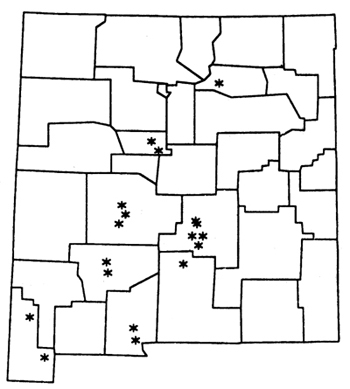
Distribution and habitat. Rio Grande Valley and adjoining hill country of southern and southwestern New Mexico, north into Mora County; desert grassland, desert scrub, juniper forest; gravel to clay-loam soils; 2,000–7,000 ft (615–2200 m).
Toxic principle. Nitro-compounds and swainsonine.
Comment. This toxic species is very similar to Astragalus nuttallianus, which apparently is not toxic and may provide valuable forage. The main difference between the two is that the pods of A. nuttallianus persist on the stem and split open from only the tip while on the stem, whereas the pods of A. emoryanus readily fall from the stem and split open from both ends while on the ground.
9. Ground-Cover Milkvetch
Astragalus humistratus Gray
Nomenclature. Specific epithet: Covering the ground, alluding to its mat-like growth.
Field recognition. Plants growing in mats, stipules united, flowers greenish to pinkish-white to yellowish, keel with a conspicuous triangular tip, pods beaked.
Description. Plants perennial. Stems slender and wiry, mostly prostrate. Pubescence dolabriform. Leaves nearly sessile, 2–7 cm long. Stipules membranous, united around the stem. Leaflets narrow to broadly egg-shaped or spatula-shaped. Racemes dense when young, 1–9 cm long, 3- to 20-flowered. Calyx with white or mixed white and black hairs, 5–8 mm long. Petals varying from greenish-white to yellowish to reddish-purple. Banner 6–12 mm long. Wings 6–11 mm long. Keel bent upwards to a triangular beak. Pods ascending to spreading, from broadly egg-shaped to narrowly oblong, ending in a prominent beak. Flowering April–September.
Toxic principle. Not known to be toxic.
Key to the varieties in New Mexico
1 Pods 6–14 mm long, 1.5–2.5 times longer than wide ... var. humivagans
1 Pods 13–20 mm long, 3–4 times longer than wide
2 Herbage greenish, the leaflets hairless on the upper surface ... var. humistratus
2 Herbage silvery, the leaflets hairy on both surfaces ... var. sonorae
Ground-Cover Milkvetch
Astragalus humistratus A. Gray var. humistratus (Figures 36, 37, 38)
Nomenclature. Varietal epithet: Covering the ground, alluding to its mat-like growth. Synonyms: Astragalus datilensis (Rydberg) Tidestrom, Pisophaca datilensis Rydberg, Batidophaca humistrata (Gray) Rydberg, Tragacantha humistrata (Gray) Kuntze, Tium humistratum (Gray) Rydberg.
Description. Leaves deep green to slightly silvery-green. Leaflets thinly hairy on the lower surface, but hairless on the upper surface. Petals greenish-white to yellowish, often with purple streaks. Pods oblong, 14–18 mm long, 4–7 mm in diameter.
Distribution and habitat. Scattered throughout the state; commonly in pine forests but ranging into dry hills and mesas and sometimes on sand bars of intermittent streams; gravel to sandy-loam soil; 4,400–8,700 ft (1300–2700 m).
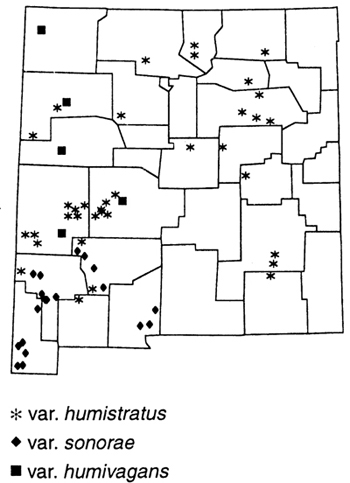
Ground-Cover Milkvetch
Astragalus humistratus A. Gray var. humivagans (Rydberg) Barneby
Nomenclature. Varietal epithet: Wandering across the ground. Synonyms: Batidophaca humivagans Rydberg.
Description. Leaves densely silvery hairy. Leaflets hairy on both surfaces. Petals greenish-white to yellowish, often with purplish streaks. Pods broadly egg-shaped, 6–14 mm long, 3–6 mm in diameter, with 10–16 ovules.
Distribution and habitat. Scattered populations in the far western mountains of New Mexico; mostly within juniper and piñon woodlands, but extending into the lower yellow pine zone; gravelly soils of volcanic origin; 4,450–8,000 ft (1350–2500 m).
Sonoran Ground-Cover Milkvetch
Astragalus humistratus A. Gray var. sonorae (Gray) Jones
Nomenclature. Varietal epithet: Of Sonora. Synonyms: Batidophaca sonorae (Gray) Rydberg, Astragalus sonorae Gray, Tragacantha sonorae (Gray) Kuntze, Batidophaca stipulacea Rydberg.
Description. Leaves densely silvery hairy. Leaflets hairy on both surfaces. Petals mostly dull purple. Pods half-moon-shaped, 13–20 mm long, 3–4 mm in diameter, with 18–26 ovules.
Distribution and habitat. Common in southwestern New Mexico; from the lower edge of the yellow pine region into yucca grasslands, hillsides, washes, canyon floors, and roadsides; gravelly to sandy soil; 5,000–6,500 ft (1500–2000 m).
10. Specklepod Locoweed
Astragalus lentiginosus Douglas ex Hooker
Nomenclature. Specific epithet: Speckled or spotted, referring to the pod. Other common names: Spotted loco, spotted milkvetch, freckled milkvetch.
Field recognition. Stems often prostrate or ascending, hairs basifixed, stipules free, flowers pink-purple to pale, pods speckled or spotted.
Description. Plants usually perennial, sometimes lasting only one season. Stems simple or branched, prostrate to erect. Pubescence absent or sparse, basifixed when present. Leaves 3–17 cm long. Stipules free. Leaflets 11–23 in number. Racemes loose, the flowers spreading with maturity. Calyx white- or black-hairy, persistent after withering. Petals pinkish or purplish (in New Mexico plants). Keel usually spotted with purple. Pods ascending or spreading, usually with mottling on the walls, stalkless, deciduous from the stem when ripe, varying in length and diameter.
Key to the varieties in New Mexico
1 Racemes in fruit short and compact, the axis not more than 4 cm long ... var. diphysus
1 Racemes in fruit elongate, 4–18 cm long ... var. australis
Southern Specklepod Locoweed
Astragalus lentiginosus Douglas ex Hooker var. australis Barneby (Figures 39, 40, 43, 45)
Nomenclature. Varietal epithet: Southern.
Description. Racemes loose, 10- to 33-flowered, the axis elongating and 4–12 cm long in fruit. Petals pink to purple, fading as they dry. Pods narrow to broadly egg-shaped, strongly curved, slightly to much inflated, 10–20 mm long, 4–15 mm in diameter. Flowering April–May.
Distribution and habitat. Southwestern New Mexico, east to the Rio Grande; foothills of desert mountains, mesquite/creosote flats, and yucca grasslands; sandy soils; 2,200–4,250 ft (650–1300 m).
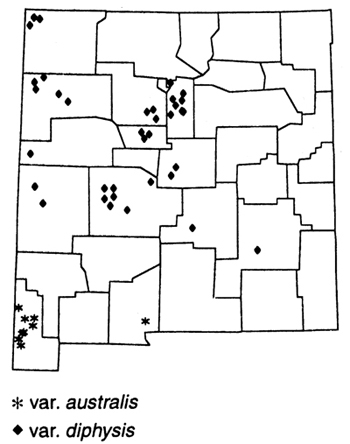
Toxic principle. Swainsonine.
Jones’s Specklepod Locoweed
Astragalus lentiginosus Douglas ex Hooker var. diphysus (Gray) Jones (Figures 41, 42, 44, 46)
Nomenclature. Varietal epithet: Double-bladdered, referring to the two-chambered pod. Synonyms: Astragalus diphysus var. albiflorus Gray, Cystium diphysum (Gray) Rydberg, Tragacantha diphysa (Gray) Kuntze.
Description. Racemes dense, 10- to 24-flowered, the axis not elongating and 1–6 cm long in fruit. Petals pink to purple, drying violet. Pods nearly round to plumply egg-shaped, curved at the tip only, usually inflated, 1–3 mm long, 7–18 mm in diameter. Flowering April–May, August–September.
Distribution and habitat. Scattered through the northwest and central portions of the state; piñon/juniper, mesquite/yucca, and grassland plains, mesas, canyon slopes, and roadsides; gravelly to sandy soil; 4,850–7,800 ft (1500–2400 m).
Toxic principle. Swainsonine.
11. Great Rushy Milkvetch
Astragalus lonchocarpus Torrey (Figures 47, 48, 49, 50, 51)
Nomenclature. Specific epithet: Long pod. Synonyms: Phaca macrocarpa Gray.
Field recognition. Growing in large, broom-like bushes, terminal leaflets continuous with the axis, flowers yellowish, pods hanging downward on noticeable stalks.
Description. Plants strongly perennial. Stems commonly coarse and robust, forming broom-like bushes, 30–60 cm tall. Pubescence basifixed, the hairs flat. Leaves with a slender weak axis, 2–13 cm long. Stipules free, 1–9 mm long. Leaflets scattered and distant, linear, the terminal leaflet not jointed but continuous with the axis, 3–11 in number, 2–36 mm long. Racemes loose, nodding, 7- to 55-flowered. Calyx with white (rarely black) hairs, 6–10 mm long. Petals yellowish or cream to almost white. Banner 13–20 mm long. Wings slightly shorter than or as long as the banner. Keel 10–14 mm long. Pods hanging downward from a stalk 3–15 mm long, the body narrow, 2–5 cm long, 3–6 mm wide. Flowering April–July.
Distribution and habitat. Scattered across the northern portion of the state; juniper, oak, and piñon foothills, woodlands, and forests, shortgrass prairie, open canyons, and roadsides; gravel, sandy-loam, and clay-loam soils; 4,900–7,800 ft (1500–2400 m).
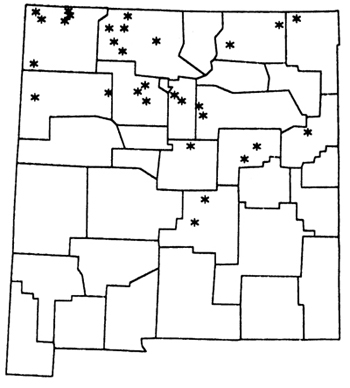
Toxic principle. Swainsonine.
12. Missouri Milkvetch
Astragalus missouriensis Nuttall
Nomenclature. Specific epithet: Of the Missouri River.
Field recognition. Plants growing in low tufts or mounds, hairs silvery and dolabriform, flowers purple, pods unilocular and persistent on the stem.
Description. Plants strongly perennial. Stems low, forming small mounds, 10–30 cm tall. Pubescence dolabriform, the hairs straight and silvery. Leaves 2–14 cm long, with a weak, persistent stalk. Stipules free, 2–9 mm long. Leaflets flat, narrowly egg-shaped, 5–21 in number, 3–17 mm long. Racemes short and loose, 3- to 15-flowered. Calyx covered with mixed black and white (or sometimes all white) hairs. Petals pink to purple, drying dull blue. Banner spatula-shaped. Keel 12–18 mm long. Pods ascending to spreading. Flowering March–September.
Toxic principle. Swainsonine.
Key to the varieties in New Mexico
1 Flowers small, the calyx 5–6 mm long, the banner 10–12 mm long, the keel 9–11 mm long ... var. mimetes
1 Flowers large, the calyx 9–14 mm long, the banner 14–24 mm long, the keel 11–19 mm long
2 Pods straight or nearly so ... var. missouriensis
2 Pods curving, half-moon-shaped ... var. amphibolus
Missouri Milkvetch
Astragalus missouriensis Nuttall var. amphibolus Barneby (Figure 56)
Nomenclature. Varietal epithet: Ambiguous (thrown from both sides), i.e., combining features of Astragalus missouriensis and A. amphioxys.
Description. Calyx 7–10 mm long. Banner 15–24 mm long, 7–13 mm wide. Wings 13–23 mm long, 2–4 mm wide. Keel 12–18 mm long, 3–4 mm wide. Pods half-moon-shaped, 2–3 cm long, 7–9 mm in diameter.
Distribution and habitat. Extreme northwestern New Mexico in the San Juan River valley; piñon/juniper woodlands and sagebrush flats; sandy soils; 5,800–8,200 ft (1750–2500 m).
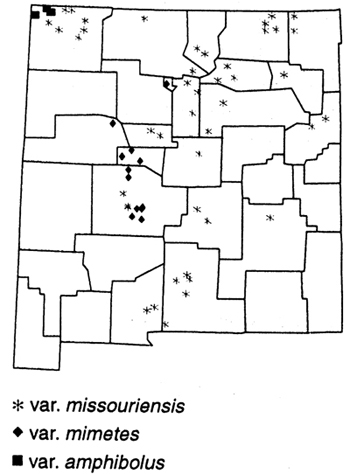
Missouri Milkvetch
Astragalus missouriensis Nuttall var. mimetes Barneby
Nomenclature. Varietal epithet: Mimic, imitating Astragalus accumbens.
Description. Calyx 5–6 mm long. Banner 9–12 mm long, 7–9 mm wide. Wings 9–11 mm long, 2–3 mm wide. Keel 9–11 mm long, 2–3 mm wide. Pods 1–3 cm long, 5–9 mm in diameter.
Distribution and habitat. West of the Rio Grande in central New Mexico; gravelly hills, stony washes, and arid clay banks in creosote and juniper communities; 4,600–5,800 ft (1400–1800 m). (See var. amphibolous)
Missouri Milkvetch
Astragalus missouriensis Nuttall var. missouriensis (Figures 52, 53, 54, 55)
Nomenclature. Varietal epithet: Of the Missouri River. Synonyms: Astragalus melanocarpus Nuttall, Tragacantha missouriensis (Nuttall) Kuntze, Xylophacos missouriensis (Nuttall) Rydberg.
Description. Calyx 9–14 mm long. Banner 14–24 mm long, 7–12 mm wide. Wings 13–23 mm long, 2–4 mm wide. Keel 12–18 mm long, 3–4 mm wide. Pods straight, 1–3 cm long, 4–10 mm in diameter, the beak 1–4 mm long.
Distribution and habitat. Widely scattered throughout much of New Mexico; prairies, grasslands, juniper woodlands, sagebrush flats, mesquite scrublands; on a variety of soils, but particularly limestone; 4,650–7,800 ft (1200–2400 m). (See var. amphibolous)
13. Woolly Locoweed
Astragalus mollissimus Torrey (Figure 62)
Nomenclature. Specific epithet: Very soft, referring to the pubescence. Other common names: Woolly loco, crazyweed, Texas loco, purple locoweed.
Field recognition. Herbage covered with dense woolly hairs, large flowers yellowish to purplish, pods turgid but not bladdery.
Description. Plants short-lived perennials. Stems clustered in small to large mounds, the outer often prostrate, the inner ascending. Pubescence basifixed, the hairs dense, woolly, often tangled. Leaves 6-26 cm long. Stipules united around the stem, with broad clasping bases. Leaflets rounded or broadly egg-shaped. Racemes 7- to 45-flowered, at first dense and short, elongating in fruit. Calyx hairy like the herbage, the hairs white or rarely black. Petals pink-purple, dull pinkish lavender, yellowish with a tinge of lilac, or creamy-white, often persistent around the maturing pod. Banner commonly spatula-shaped. Wings about as long as the banner. Keel shorter than the wings. Pods lance-shaped, egg-shaped, or half-moon-shaped.
Toxic principle. Swainsonine.
Key to the varieties in New Mexico
1 Pods hairless
2 Petals purple or tinged with purple; calyx-tube broad, 3-5 mm in diameter ... var. mollissimus
2 Petals cream-colored; calyx-tube narrow, 1-3 mm in diameter ... var. earlei
1 Pods densely covered with hairs
3 Pods with a single chamber in the beak ... var. thompsonae
3 Pods with two chambers in the beak
4 Racemes 7- to 12-flowered; pods 7-13 mm in diameter ... var. matthewsii
4 Racemes usually 12- to many-flowered; pods 4-8 mm in diameter
5 Plants usually robust and with short leafy stems; leaves 9-26 cm long, the leaflets 6-25 mm long; keels 14-19 mm long; longest hairs of the pod 1-1.6 mm long ... var. bigelovii
5 Plants dwarf and without leafy stems; leaves (4)6-16 cm long, the leaflets 3-13 mm long; keels 12-15 mm long; longest hairs of the pod 1.6-2.6 mm long ... var. mogollonicus
Bigelow’s Woolly Locoweed
Astragalus mollissimus Torrey var. bigelovii (Gray) Barneby (Figures 57, 58, 59, 60, 69)
Nomenclature. Varietal epithet: After John Milton Bigelow, early botanist-explorer. Synonyms: Astragalus bigelovii Gray.
Description. Stems 3–17 cm long. Leaves 9–26 cm long. Leaflets 13–27 in number, 6–25 mm long. Racemes 15- to 45-flowered. Calyx 10–14 mm long. Petals pink-purple. Banner 17–22 mm long, 9–11 mm wide. Wings 15–21 mm long, 2–3 mm wide. Keel 13–19 mm long, 3–4 mm wide. Pods broadly egg-shaped to lance-shaped, tapering to a point, gently bent or straight, sometimes turgid, densely hairy, the longest hairs 1–2 mm long, the beak two-chambered, the body 1–2 cm long and 4–8 mm in diameter. Flowering February–June, occasionally again in the fall.
Distribution and habitat. Southwest quarter of the state; dry plains and foothills, mesquite grasslands, sometimes in piñon/juniper foothills; most commonly on caliche soils, but also on sandy loams and basalt; 4,000–7,500 ft (1230–2300 m).
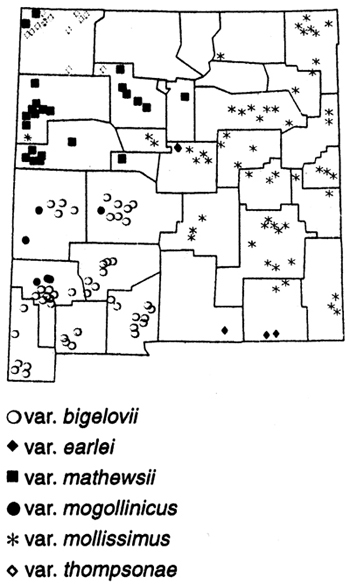
Earle’s Woolly Locoweed
Astragalus mollissimus Torrey var. earlei (Greene ex Rydberg) Tidestrom
Nomenclature. Varietal epithet: After Franklin Sumner Earle, plant collector. Synonyms: Astragalus earlei Greene ex Rydberg.
Description. Stems 10–20 cm long. Leaves 8–32 cm long. Leaflets 19–35 in number, 5–45 mm long. Racemes 15- to 36-flowered. Calyx 9–11 mm long. Petals pink-purple or, if yellowish, then tipped with purple. Banner 12–18 mm long, 4–8 mm wide. Wings 12–16 mm long, 1–3 mm wide. Keel 9–13 mm long, 2–3 mm wide. Pods bent, hairless, contracted at the tip into a short one-chambered beak, the body 9–14 mm long and 4–7(9) mm in diameter. Flowering mostly April–May.
Distribution and habitat. Known in New Mexico from only a few collections in the southeastern quarter; dry hills and plains, grasslands, and juniper woodlands; caliche and volcanic soils; 3,700–5,800 ft (1100–1800 m). (See var. bigelovii)
Matthews’s Woolly Locoweed
Astragalus mollissimus Torrey var. matthewsii (Watson) Barneby (Figures 67, 68, 69)
Nomenclature. Varietal epithet: After Washington Matthews, ethnobotanist and archeologist. Synonyms: Astragalus matthewsii Watson.
Description. Stems essentially absent, not more than 1.5 cm long, concealed by stipules. Leaves 3–12 cm long. Leaflets 11–23 in number, 3–12 mm long. Racemes usually concealed in the foliage, 5- to 12-flowered. Calyx 10–13 mm long. Petals pale purple. Banner 18–22 mm long. Wings 17–20 mm long, 2–3 mm wide. Keel 14–18 mm long, 3–4 mm wide. Pods broadly egg-shaped, plump, turgid, woolly hairy, bent at the tip with a two-chambered beak, the body 12–18 mm long and 7–13 mm in diameter. Flowering May–June.
Distribution and habitat. North-central New Mexico, ranging west into Arizona; open slopes and hilltops, mostly in yellow pine forest, but descending along canyons into the piñon/juniper hills and sagebrush flats; sandy, gravelly, granitic, or volcanic soils; 6,500–8,300 ft (2000–2550 m). (See var. bigelovii)
Mogollon Woolly Locoweed
Astragalus mollissimus Torrey var. mogollonicus (Greene) Barneby
Nomenclature. Varietal epithet: Of the Mogollon Mountains. Synonyms: Astragalus mogollonicus Greene, A. bigelovii (Gray) Barneby var. mogollonicus (Greene) Barneby.
Description. Stems commonly absent. Pubescence becoming rusty. Leaves 4–16 cm long. Leaflets 9–23 in number, 3–13 mm long. Racemes broadly egg-shaped, dense, 12- to 32-flowered. Calyx 10–15 mm long. Petals pink-purple. Banner 16–22 mm long. Wings 15–20 mm long, 2–3 mm wide. Keel 12–15 mm long, 3–4 mm wide. Pods narrowly egg-shaped, straight to slightly bent, covered with hairs, the beak two-chambered, the body 9–13 mm long and 4–6 mm in diameter. Flowering April–June.
Distribution and habitat. Along the Mogollon Escarpment in western New Mexico; open ponderosa pine forests, descending to rocky knolls in the piñon/juniper belt; most common on volcanic soils, but sometimes also on limestone; 6,100–8,500 ft (1850–2600 m). (See var. bigelovii)
Common Woolly Locoweed
Astragalus mollissimus Torrey var. mollissimus (Figures 61, 63)
Nomenclature. Varietal epithet: Very soft, referring to the pubescence. Synonyms: Phaca villosa James ex Watson, Astragalus simulans Cockerell.
Description. Stems 2–14 cm long. Leaves 7–25 cm long. Leaflets 15–33 in number, 5–22 mm long. Racemes 15- to 40-flowered. Calyx 9–14 mm long. Petals yellowish to pinkish or pink-purple. Banner 16–21 mm long, 7–11 mm wide. Wings 15–21 mm long, 2–3 mm wide. Keel 14–18 mm long, 3–4 mm wide. Pods narrowly egg-shaped to lance-shaped, straight or bent near the middle, commonly hairless, the tip with a short one-chambered beak, the body 1–3 cm long and 4–7 mm in diameter. Flowering late March–June.
Distribution and habitat. Eastern half of the state; dry pine forests, prairies, plains, mesas, fields, and roadsides; loam, sand, to gravelly soil; 4,500–8,000 ft (1400–2500 m). (See var. bigelovii)
Thompson’s Woolly Locoweed
Astragalus mollissimus Torrey var. thompsonae (Watson) Barneby (Figures 64, 65, 66, 69)
Nomenclature. Varietal epithet: After Mrs. Ellen P. Thompson, sister of Captain James W. Powell, explorer of the Grand Canyon. Synonyms: Astragalus thompsonae Watson.
Description. Stems short and inconspicuous, generally not more than 3 cm long. Leaves 3–20 cm long. Leaflets 15–35 in number, 3–18 mm long. Racemes 7- to 25-flowered. Petals pink-purple. Banner 18–25 mm long. Wings 17–24 mm long, 2–3 mm wide. Keel 15–20 mm long, 3–4 mm wide. Pods narrowly egg-shaped, woolly hairy, bent in the middle to nearly a right angle, the beak one-chambered, the body 11–23 mm long and 6–11 mm in diameter. Flowering April–June.
Distribution and habitat. Found only in the northwest corner of the state; mesas, dry hillsides, at the foot of cliffs and buttes, common with junipers, or in rolling grasslands; sandy-clay to sandy soils; 4,600–7,000 ft (1400–2150 m). (See var. bigelovii)
14. Nuttall’s Milkvetch
Astragalus nuttallianus DeCandolle (Figures 71, 72)
Nomenclature. Specific epithet: After Thomas Nuttall, early plant explorer. Synonyms: Astragalus micranthus Nuttall, Hamosa imperfecta Rydberg. Other common names: Small-flowered milkvetch.
Field recognition. Spring or winter annuals forming mats, pubescence basifixed, flowers very small and purplish to bluish to sometimes whitish, pods persistent on the stem and splitting open at only the tip while on the stem.
Description. Plants spring or winter annuals. Stems branching from the base, often forming mats, 1–45 cm long. Pubescence basifixed when present, the hairs absent to densely spreading. Leaves stalked, 1–9 cm long. Stipules free, 1–9 mm long. Leaflets elongated egg-shaped, pointed at the tip, almost always flat, 5–23 in number, 2–17 mm long. Racemes 1- to 15-flowered. Calyx hairless to densely hairy, 3–6 mm long. Petals whitish, pinkish, to purplish. Banner with a shallow notch, 4–13 mm long. Wings spatula- to football-shaped, 4–11 mm long. Keel 4–9 mm long. Pods stalkless or with a short stalk, linear in profile, nearly straight, three-sided when ripe, persistent and splitting open from the tip while on the stem, 1–2 cm long, 2–4 mm wide. Flowering April–June, occasionally again August–September.
Distribution and habitat. Widely distributed throughout the state; dry plains and mesas, grasslands, ponderosa pine forests in the southern mountains; sandy, rocky, volcanic, and shale soils; 4,000–7,200 ft (1230–2215 m).
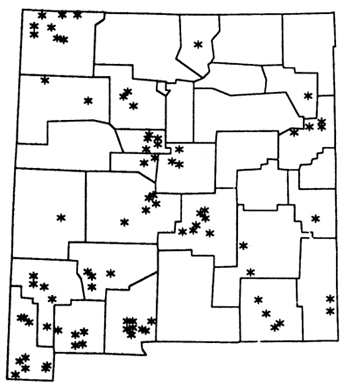
Toxic principle. Very low amounts of swainsonine (< 0.0002 ppm). Apparently non-toxic.
Comment. Nuttall’s milkvetch in New Mexico consists of several confusing and sometimes intergrading forms, some of which have been recognized at the varietal level. Though these forms are taxonomically important and interesting, their identification can be difficult and arbitrary. We have decided not to include them in this manual. This apparently non-toxic species is very similar to Astragalus emoryanus, which produces abundant amounts of toxic nitro-compounds and the alkaloid swainsonine. The main difference between the two is that the pods of A. emoryanus readily fall from the stem and split open at both ends while drying on the ground, whereas the pods of A. nuttalianus are more persistent on the stem, splitting open only at the tip while attached to the flowering stalk.
15. Stinking Milkvetch
Astragalus praelongus Sheldon (Figure 73)
Nomenclature. Specific epithet: Very tall.
Field recognition. Plants with distinct pungent smell of selenium, foliage green and nearly hairless, flowers yellowish and drooping.
Description. Plants strongly perennial, hairless or thinly covered with straight hairs. Stems in clumps with hardened bases, 20–80 cm tall. Pubescence basifixed. Leaves hairless, or at least appearing so, 4–22 cm long. Stipules free, 3–9 mm long. Leaflets round, lance- or spatula-shaped, 7–33 in number, 3–50 mm long. Racemes dense at maturity, 4–15 cm long, 10- to 30-flowered, the flowers drooping. Calyx hairless or thinly covered with black hairs, 6–14 mm long. Petals yellowish with a spotted keel tip, sometimes faintly pink. Banner 15–24 mm long. Wings 15–22 mm long. Keel 11–17 mm long, with a spotted tip. Pods erect to spreading, stalkless or with a short stalk less than 3 mm long, turgid (but not bladdery), egg- or globe-shaped, slightly hairy or hairless. Flowering April–July.
Toxic principle. Selenium.
Key to the varieties in New Mexico
1 Body of the pod round and plump, 10–15 mm in diameter ... var. praelongus
1 Body of the pod narrow, 6–10 mm in diameter ... var. ellisiae
Ellis’s Stinking Milkvetch
Astragalus praelongus Sheldon var. ellisiae (Rydberg) Barneby (Figures 74, 78)
Nomenclature. Varietal epithet: After Charlotte Cortland Ellis, early plant collector. Synonyms: Jonesiella ellisiae Rydberg.
Description. Pods narrowly egg-shaped or football-shaped, 18–34 mm long, 6–10 mm in diameter.
Distribution and habitat. Eastern half of New Mexico; bluffs, clay knolls, plains, bottomlands, piñon/juniper woodlands, and ponderosa pine forest; on selenium-rich soils and alkaline soils of shale or volcanic parent material; 2,750–7,100 ft (850–2200 m).
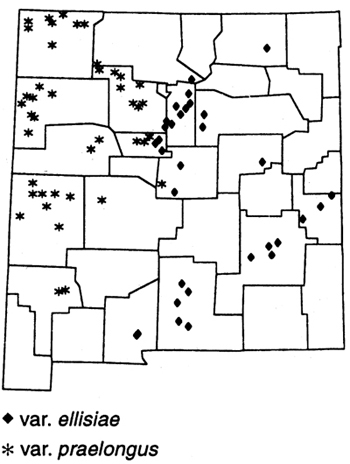
Common Stinking Milkvetch
Astragalus praelongus Sheldon var. praelongus (Figures 75, 76, 77, 78)
Nomenclature. Varietal epithet: Very tall. Synonyms: Jonesiella recendens Rydberg, J. mearnsii Rydberg.
Description. Pods oblong to broadly egg-shaped, 20–40 mm long, 10–15 mm in diameter.
Distribution and habitat. Western plains of New Mexico; bluffs, clay knolls, plains, bottomlands, piñon/juniper woodlands, and ponderosa pine forest; on selenium-rich soils and alkaline soils of shale or volcanic parent material; 2,750–7,100 ft (850–2200 m). (See var. ellisiae)
16. Alkali Milkvetch
Astragalus racemosus Pursh
Nomenclature. Specific epithet: Raceme, referring to the flower clusters.
Field recognition. Plants with a distinct pungent smell of selenium, foliage hairless, flowers whitish to yellowish, pods three-sided and on a stalk.
Description. Plants strongly perennial. Stems 15–60 cm tall, in bushy clumps. Pubescence basifixed when present, but sparse. Leaves hairless, 4–15 cm long. Stipules united around the stem, 3–12 mm long. Leaflets 9–31 in number, 1–4 cm long, flat or loosely folded. Racemes commonly dense, becoming loose at maturity, 15- to 70-flowered, 5–15 cm long, the flowers drooping. Calyx pale, sometimes pinkish, with white hairs, 7–19 mm long. Petals white or yellowish, sometimes tinged with lilac or pink-purple. Banner 16–20 mm long, 6–11 mm wide. Wings 12–19 mm long, 2–4 mm wide. Keel 11–15 mm long, 3–4 mm wide. Pods drooping, on a stalk, the body linear to football-shaped, triangular in cross-section with three flat faces, 10–30 mm long, 3–8 mm in diameter, on a stalk 3–7 mm long. Flowering May–July.
Toxic principle. Selenium.
Key to the varieties in New Mexico
1 Calyx 7–10 mm long; leaflets mostly narrow, linear to narrowly football-shaped ... var. racemosus
1 Calyx 10–19 mm long; leaflets broader,broadly football-shaped to egg-shaped ... var. longisetus
Jones’s Alkali Milkvetch
Astragalus racemosus Pursh var. longisetus Jones (Figures 79, 80, 81, 82, 83)
Nomenclature. Varietal epithet: With long bristles. Synonyms: Tium platycarpum Rydberg.
Description. Plants commonly more robust than var. racemosus. Leaflets broadly football- to egg-shaped, 6–12 mm wide. Calyx 10–19 mm long.
Distribution and habitat. Northeast corner of the state; clay bluffs and flats, along creeks and streams, shortgrass prairie, and juniper/grassland communities; selenium soils; 4,500–7,000 ft (1380–2200 m).
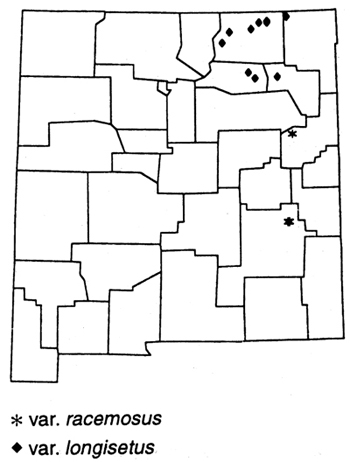
Common Alkali Milkvetch
Astragalus racemosus Pursh var. racemosus
Nomenclature. Varietal epithet: Raceme, referring to the flower clusters. Synonyms: Astragalus racemosus Purah var. brevisetus Jones.
Description. Leaflets 3–6 mm wide. Calyx 7–9 mm long.
Distribution and habitat. East-central New Mexico; bluffs, gullies, and barren knolls; clay, shale, or gypsum soils that contain selenium; 1,700–4,300 ft (525–1350 m). (See var. longisetus)
17. Silverline Locoweed
Astragalus tephrodes Gray (Figures 84, 85, 86, 87)
Nomenclature. Specific epithet: Ash-gray. Synonyms: Tragacantha tephrodes (Gray) Kuntze, Xylophacos tephrodes (Gray) Rydberg. Other common names: Ashen milkvetch.
Field recognition. Plants growing in low tufts, leaflets silvery-hairy on one side but nearly hairless on the other, small flowers bluish to purplish, pods small with a thin wall.
Description. Plants perennial. Stems usually prostrate, shorter than the longest leaves and inflorescence, 1–15 cm long. Pubescence basifixed, the foliage generally covered with straight, loose hairs. Leaves 5–19 cm long. Stipules free, 2–7 mm long. Leaflets round, diamond- or inversely lance-shaped, loosely folded, silky hairy below but green and nearly hairless above, 11–31 in number, 3–16 mm long. Racemes loose, 9- to 20-flowered, 2–6 cm long in fruit. Calyx covered with all-white or black and white straight hairs, 5–9 mm long. Petals pink-purple to dull lilac, sometimes vaguely white, turning blue when dried. Banner 12–18 mm long. Wings shorter to slightly longer than the banner. Keel 10–15 mm long. Pods narrow to broadly egg-shaped, 10–20 mm long, 5–8 mm in diameter, the beak 3–6 mm long. Flowering March–October.
Distribution and habitat. Rather common in the southwestern quarter of New Mexico; oak, piñon, and juniper woodlands, creosote flats, yucca grasslands; sandy to ground soils primarily of granitic or volcanic origin; 4,700–7,000 ft (1450–2200 m).
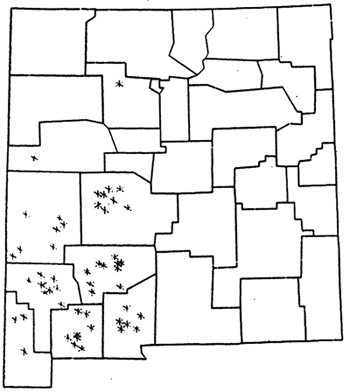
Toxic principle. Swainsonine.
Comment. New Mexico plants belong to the variety tephrodes.
18. Lambert’s Locoweed
Oxytropis lambertii Pursh (Figures 88, 89, 90, 91)
Nomenclature. Specific epithet: After Alymer Bourke Lambert. Synonyms: Aragallus lambertii (Pursh) Greene. Other common names: Crazyweed, Lambert’s crazyweed, purple locoweed.
Field recognition. Leaves basal, herbage silvery hairy, racemes very long in fruit, flowers purple, the keel drawn out into a pointed beak.
Description. Plants perennial. Stems tufted, 25–45 cm tall. Pubescence dolabriform and appressed, the herbage silky, silvery to greenish. Leaves nearly all basal and not borne along the stem, 5–24 cm long. Stipules united around the stem, rupturing at maturity, 7–24 mm long. Leaflets linear to egg-shaped, 7–15 in number, 7–32 mm long, 3–8 mm wide. Racemes with flowers usually spreading at wide angles, 8- to 28-flowered, 5–16 cm long at maturity. Calyx with white silky hairs, 8–10 mm long. Petals pink-purple, sometimes whitish. Banner 18–23 mm long, 8–11 mm wide. Wings 15–20 mm long, 5–7 mm wide at the tip. Keel 13–16 mm long. Pods stalkless or on a short stalk, erect or spreading at maturity, oblong to lance-shaped, lightly hairy, 15–25 mm long, 2.5–5 mm in diameter. Flowering April–October.
Distribution and habitat. Widely scattered across the northern and western portions of the state; plains, mesas, pine and juniper forests and woodlands; gravelly, sandy, and silty soils; 5,000–9,500 ft (1500–2950 m).

Toxic principle. Swainsonine.
Comment. Lambert’s locoweed has been divided into three very weakly differentiated varieties; nearly all the plants in New Mexico belong to var. bigelovii Gray.
19. White Locoweed
Oxytropis sericea Nuttall (Figures 92, 93, 94, 95)
Nomenclature. Specific epithet: Silky. Synonyms: Aragallus pinetorum Heller, A. pinetorum var. veganus Cockerell, Oxytropis pinetorum Wooton & Standley, O. vegana Wooton & Standley. Other common names: Whitepoint locoweed, silky locoweed, silky crazyweed.
Field recognition. Leaves basal, herbage silvery hairy, flowers whitish to yellowish, the keel with a sharp point on the tip.
Description. Plants strongly perennial. Stems tufted, 15–35 cm tall. Pubescence basifixed, the herbage silky, silvery to grayish. Leaves 4–30 cm long. Stipules united around the stem when young but easily ruptured, 7–28 mm long. Leaflets egg- to lance-shaped, 11–19 in number, 10–40 mm long, 2–10 mm wide. Racemes usually becoming loose with age, 6- to 27-flowered, 2–18 cm long in fruit. Calyx with light or dark silky hairs, 8–12 mm long. Petals commonly whitish or yellowish (with or without a purple spot on the keel). Banner 15–26 mm long, 8–12 mm wide. Wings 15–21 mm long, 5–8 mm wide at the tip. Keel 13–19 mm long. Pods stalkless, broadly football- to egg-shaped, silky hairy, becoming woody and hairless in age, 10–30 mm long, 4–8 mm in diameter. Flowering April–September.
Distribution and habitat. Northern and central mountains; plains and prairies, sagebrush, oak, and mixed conifer communities; gravel, sandy, and clay-loam soil; 3,000–11,000 ft (1000–3300 m).
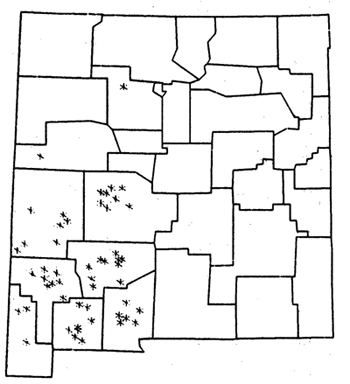
Toxic principle. Swainsonine.
Figures

Figure 8. Astragalus agrestis, pressed plant.

Figure 9. A. agrestis, raceme.

Figure 10. A. allochrous var. allochrous, flowers and foliage.

Figure 11. A. allochrous var. playanus, flowers and foliage.

Figure 12. A. allochrous var. allochrous, seedpods.

Figure 13. A. allochrous var. playanus, plant with seedpods.

Figure 14. A. amphioxys, pressed plant.

Figure 15. A. amphioxys, raceme and flowers.

Figure 16. A. amphioxys, seedpod.

Figure 17. A. bisulcatus var. bisulcatus.

Figure 18. A. bisulcatus var. bisulcatus.

Figure 19. A. bisulcatus var. haydenianus.

Figure 20. A. bisulcatus var. bisulcatus, stem and leaf showing stipules.

Figure 21. A. bisulcatus var. bisulcatus, flowers.

Figure 22. A. bisulcatus seedpods, var. haydenianus (top) and var. bisulcatus (bottom).

Figure 23. A. ceramicus, pressed plant.

Figure 24. A. ceramicus, seedpod.

Figure 25. A. crassicarpus var. cavus, pressed plant.

Figure 26. A. crassicarpus var. crassicarpus, seedpods.

Figure 27. A. crassicarpus var. cavus, seedpods.

Figure 28. A. drummondii.

Figure 29. A. drummondii, flowers.

Figure 30. A. drummondii, hairs on stem and foliage.

Figure 31. A. drummondii, hairs on leaflets.

Figure 32. A. drummondii, foliage and seedpods.

Figure 33. A. emoryanus.

Figure 34. A. emoryanus, flowers.
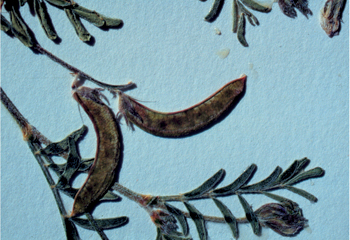
Figure 35. A. emoryanus, seedpods.
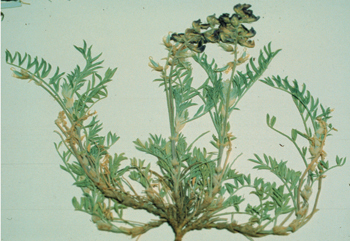
Figure 36. A. humistratus var. humistratus, pressed plant.

Figure 37. A. humistratus var. humistratus,stipules and seedpods.
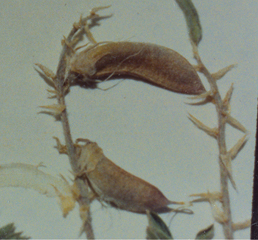
Figure 38. A. humistratus var. humistratus, seedpods.
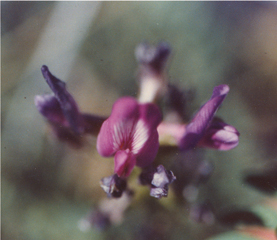
Figure 39. A. lentiginosus var. australis, flower.
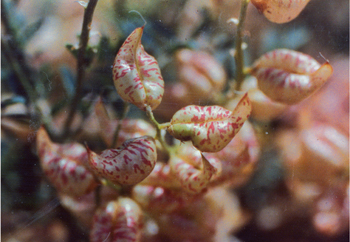
Figure 40. A. lentiginosus var. australis, seedpod.
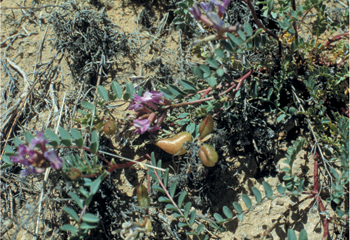
Figure 41. A. lentiginosus var. diphysus.
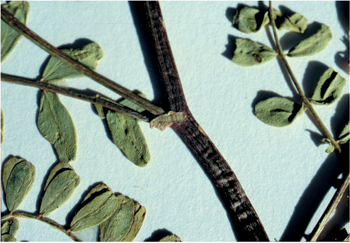
Figure 42. A. lentiginosus var. diphysus, stipule.
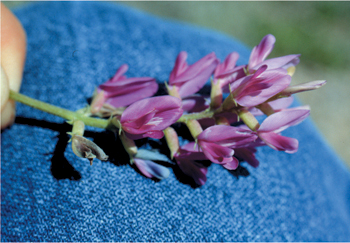
Figure 43. A. lentiginosus var. australis, flowers.
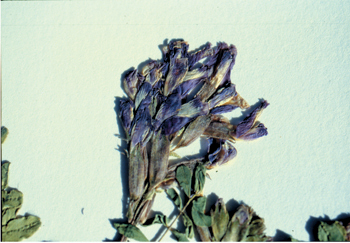
Figure 44. A. lentiginosus var. diphysus, raceme.
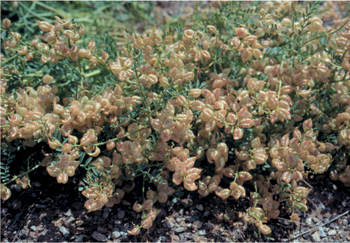
Figure 45. A. lentiginosus var. australis, seedpods.

Figure 46. A. lentiginosus var. diphysus, seedpods.
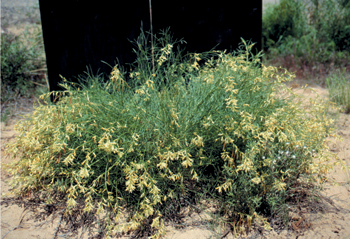
Figure 47. A. lonchocarpus.
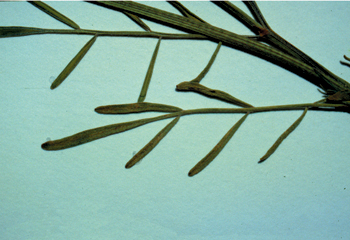
Figure 48. A. lonchocarpus, leaf and leaflets.
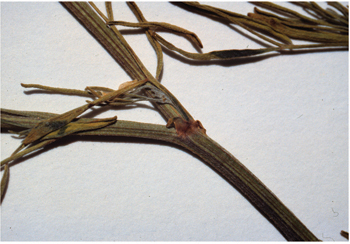
Figure 49. A. lonchocarpus, stipule.
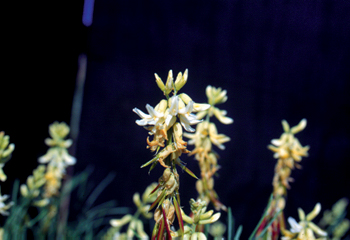
Figure 50. A. lonchocarpus, raceme.
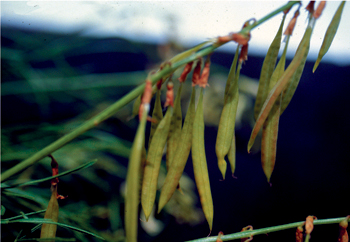
Figure 51. A. lonchocarpus, seedpods.
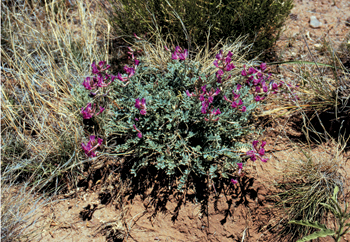
Figure 52. A. missouriensis var. missouriensis.
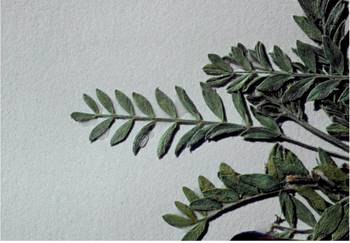
Figure 53. A. missouriensis var. missouriensis, leaf and leaflets.

Figure 54. A. missouriensis var. missouriensis, flowers.
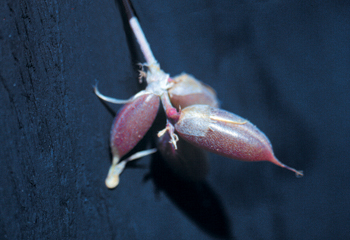
Figure 55. A. missouriensis var. missouriensis, seedpods.
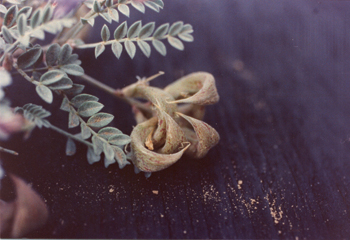
Figure 56. A. missouriensis var. amphibolus, seedpods.
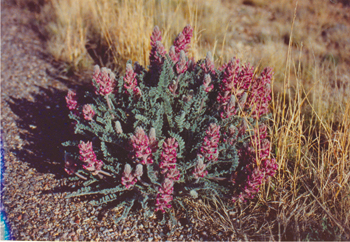
Figure 57. A. mollissimus var. bigelovii.

Figure 58. A. mollissimus var. bigelovii, leaf and leaflets.
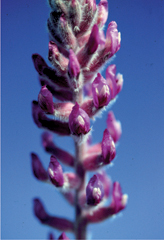
Figure 59. A. mollissimus var. bigelovii, raceme.
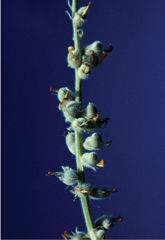
Figure 60. A. mollissimus var. bigelovii, seedpods.
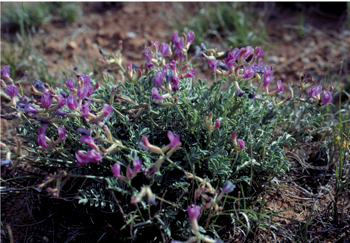
Figure 61. A. mollissimus var. mollissimus.
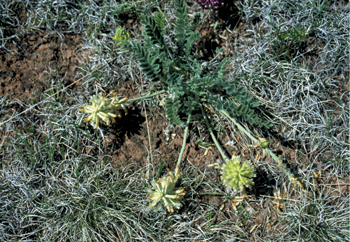
Figure 62. A. mollissimus.

Figure 63. A. mollissimus var. mollissimus, seedpods.

Figure 64. A. mollissimus var. thompsonae.
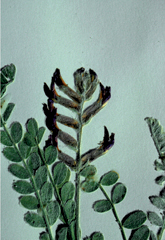
Figure 65. A. mollissimus var. thompsonae,raceme, leaf, and leaflets.
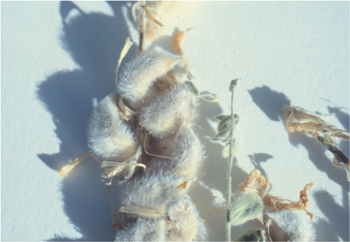
Figure 66. A. mollissimus var. thompsonae, seedpods.
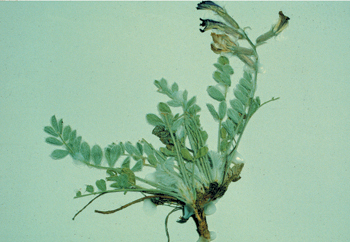
Figure 67. A. mollissimus var. matthewsii, pressed plant.

Figure 68. A. mollissimus var. matthewsii, seedpods.
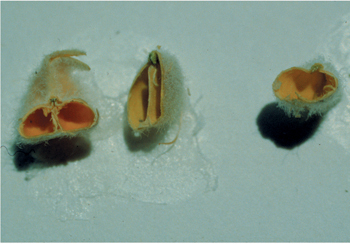
Figure 69. A. mollissimus seedpods in cross section, var. matthewsii (left), var. bigelovii (center), and var. thompsonae (right).
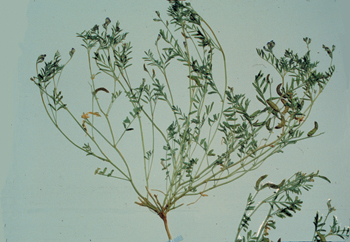
Figure 70. A. emoryanus, pressed plant.
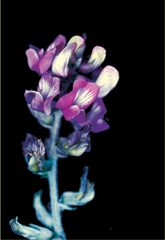
Figure 71. A. nuttallianus, raceme.
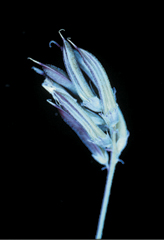
Figure 72. A. nuttallianus, seedpods.
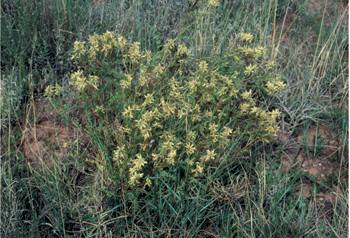
Figure 73. A. praelongus.
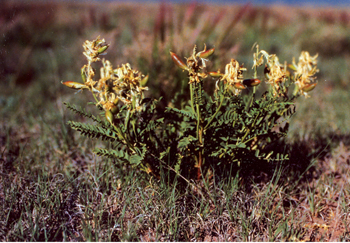
Figure 74. A. praelongus var. ellisiae.
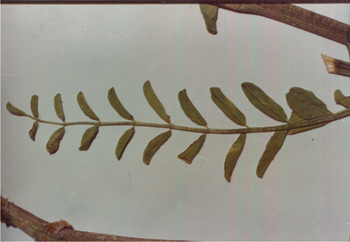
Figure 75. A. praelongus var. praelongus, leaf and leaflet.
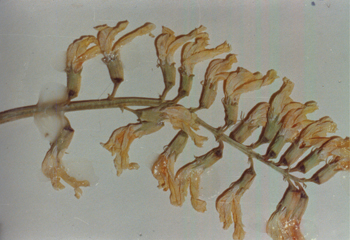
Figure 76. A. praelongus var. praelongus, raceme.
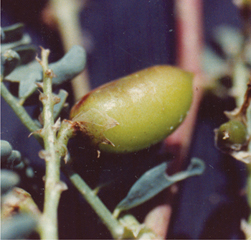
Figure 77. A. praelongus var. praelongus, seedpod.
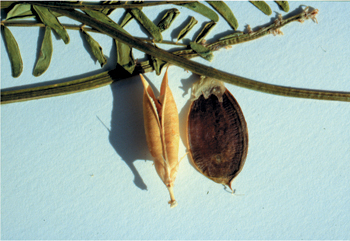
Figure 78. A. praelongus seedpods, var. praelongus (left) and var. ellisiae (right).
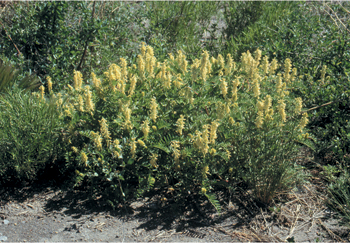
Figure 79. A. racemosus var. longisetus.
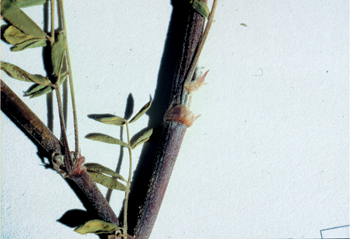
Figure 80. A. racemosus var. longisetus, stipule.
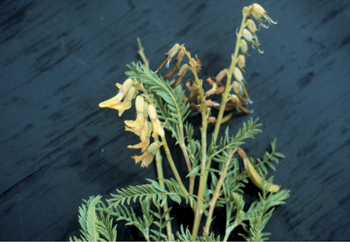
Figure 81. A. racemosus var. longisetus, flowers and seedpods.
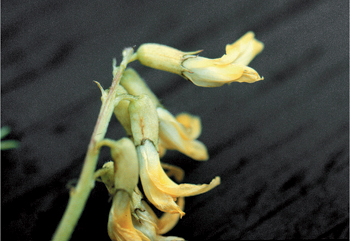
Figure 82. A. racemosus var. longisetus, raceme.
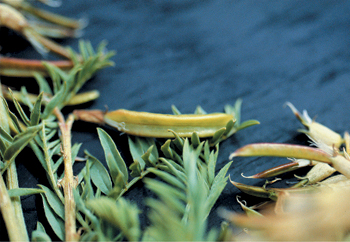
Figure 83. A. racemosus var. longisetus, seedpod.
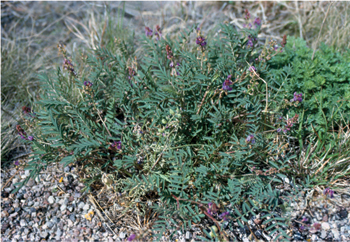
Figure 84. A. tephrodes.
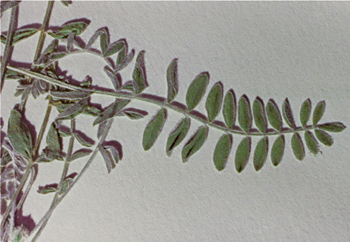
Figure 85. A. tephrodes, leaflets.
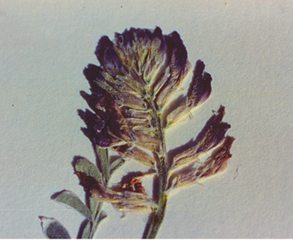
Figure 86. A. tephrodes, raceme.
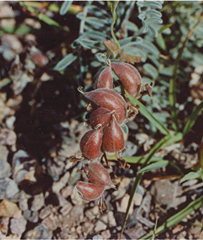
Figure 87. A. tephrodes var. tephrodes, seedpods.
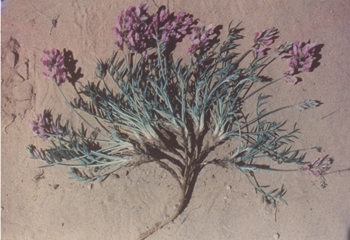
Figure 88. Oxytropis lambertii.

Figure 89. O. lambertii, leaf and leaflets.

Figure 90. O. lambertii, raceme.
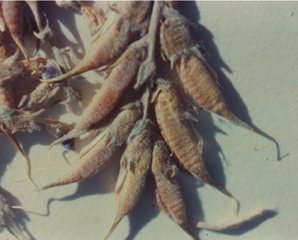
Figure 91. O. lambertii, seedpods.
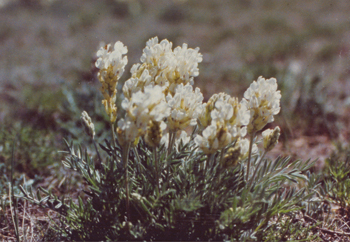
Figure 92. O. sericea.
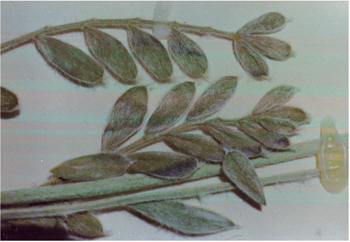
Figure 93. O. sericea, leaf and leaflets.

Figure 94. O. sericea.
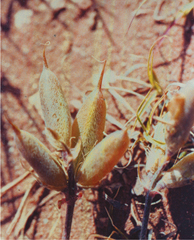
Figure 95. O. sericea, seedpods.
References
Allison, C.D. 1984. Locoweeds and livestock poisoning [Bulletin 400 B-15]. Las Cruces: New Mexico State University Cooperative Extension Service.
Allred, K.W. 1991a. An annotated checklist of poisonous or injurious range plants of New Mexico [Bulletin 400 B-14]. Las Cruces: New Mexico State University Cooperative Extension Service.
Allred, K.W. 1991b. The biology of Astragalus allochrous: Halfmoon locoweed (var. allochrous) and Wooton’s locoweed (var. playanus) [Research Report 652]. Las Cruces: New Mexico State University Agricultural Experiment Station.
Barneby, R.C. 1952. A revision of the North American species of Oxytropis DC. Proceedings of the California Academy of Sciences, 27, 177–312.
Barneby, R.C. 1964. Atlas of North American Astragalus. Bronx: New York Botanical Garden.
Bohmont, D.W. 1952. Chemical control of poisonous range plants [Bulletin 313, pp. 9–13]. Laramie: Wyoming Agricultural Experiment Station.
Cheeke, P.R., and L.R. Shull. 1985. Natural toxicants in feeds and poisonous plants. Westport, CT: AVI Publishing Company, Inc.
Davis, D., P. Schwarz, T. Hernandez, M. Mitchell, B. Warnock, and A.D. Elbein. 1984. Isolation and characterization of swainsonine from Texas locoweed (Astragalus emoryanus). Plant Physiology, 76, 972–975.
Hartley, W.J., D.C. Baker, and L.F. James. 1989. Comparative pathological aspects of locoweed and Swainsona poisoning in livestock. In L.F. James, A.D. Elbein, R.J. Molyneux, and C.D. Warren (Eds.), Swainsonine and related glycoside inhibitors (pp. 50–56). Ames: Iowa State University Press.
Holechek, J.L., R.D. Pieper, and C.H. Herbel. 1989. Range management: Principles and practices. Elgnewood Cliffs, NJ: Prentice Hall.
James, L.F. 1983. Poisonous plants: Aliphatic nitro-containing Astragalus. Rangelands, 5, 256–257.
James, L.F., and K.R. Van Kampen. 1971. Effects of locoweed intoxication on the genital tract of the ram. American Journal of Veterinary Research, 32, 1293–1295.
James, L.F., W.J. Hartley, and K.R. Van Kampen. 1981. Syndromes of Astragalus poisoning in livestock. Journal of the American Veterinary Medical Association, 178, 146–150.
James, L.F., W.J. Hartley, and K.R. Van Kampen. 1983. Relationship between ingestion of the locoweed Oxytropis sericea and congestive right-side heart failure in cattle. American Journal of Veterinary Research, 44, 254–259.
James, L.F., K.E. Panter, and R.J. Molyneux. 1992a. Selenium poisoning in livestock. In L.F. James, R.F. Keeler, E.M. Bailey, Jr., P.R. Cheeke, and M.P. Hegarty (Eds.), Poisonous plants: Proceedings of the third international symposium (pp. 153–158). Ames: Iowa State University Press.
James, L.F., A.D. Elbein, R.J. Molyneux, and C.D. Warren (Eds.). 1989. Swainsonine and related glycosidase inhibitors. Ames: Iowa State University Press.
James, L.F., K.E. Panter, D.B. Nielsen, and R.J. Molyneux. 1992b. The effect of natural toxins on reproduction in livestock. Journal of Animal Science, 70, 1573–1579.
James, L.F., W.J. Hartley, D. Neilsen, S. Allen, and K.E. Panter. 1986. Locoweed (Oxytropis sericea) poisoning and congestive heart failure in cattle. Journal of the American Veterinary Medical Association, 189, 1549–1556.
James, L.F., K.L. Bennett, K.G. Parker, R.F. Keeler, W. Binns, and B. Lindsey. 1968. Loco plant poisoning in sheep. Journal of Range Management, 21, 360–365.
Kingsbury, J.M. 1964. Poisonous plants of the United States and Canada. Englewood Cliffs, NJ: Prentice-Hall.
Kothmann, M.M., W.S. Rawlins, and J. Bluntzer. 1975. Vegetation and livestock responses to grazing management on the Texas Experimental Ranch [PR-3310]. College Station: Texas Agricultural Experiment Station.
Krueger, W.C., and L.A. Sharp. 1978. Management approaches to reduce livestock losses from poisonous plants on rangeland. Journal of Range Management, 31, 347–350.
Marsh, C.D. 1909. The locoweed disease of the plains [Animal Industry Bulletin 112]. Washington, D.C.: United States Department of Agriculture.
Marsh, C.D., and A.B. Clawson. 1936. The locoweed disease [Farmers Bulletin 1054]. Washington, D.C.: United States Department of Agriculture.
Martin, S.C., and D.E. Ward. 1976. Perennial grasses respond inconsistently to alternate year seasonal rest. Journal of Range Management, 29, 346.
McDaniel, K.C. 1993. Silky crazyweed (Oxytropis sericea Nutt. ex T. & G.) and broom snakeweed (Gutierrezia sarothrae (Pursh) Shinners) control with various herbicides. In Livestock research briefs and cattle growers’ shortcourse. Las Cruces: New Mexico State University Agricultural Experiment Station.
Molyneux, R.J., and L.F. James. 1982. Loco intoxication: Indolizidine alkaloids of spotted locoweed (Astragalus lentiginosus). Science, 216, 190–196.
Nielsen, D.B. 1988. Economic impact of poisonous plants on rangeland livestock industry. Journal of Animal Science, 66, 2330–2333.
Nielsen, D.B., and L.F. James. 1992. The economic impacts of livestock poisonings by plants. In L.F. James, R.F. Keeler, P.R. Cheeke, and E.M. Bailey, Jr. (Eds.), Poisonous plants: Proceedings of the third international symposium (pp. 3–10). Ames: Iowa State University Press.
Olson, O.E. 1978. Selenium in plants as a cause of livestock poisoning. In R.F. Keeler, K.R. Van Kampen, and L.F. James (Eds.), Effects of poisonous plants on livestock (pp. 121–134). New York: Academic Press.
Panter, K.E., T.D. Bunch, L.F. James, and D.C. Sisson. 1987. Ultrasonographic imaging to monitor fetal and placental developments in ewes fed locoweed (Astragalus lentiginosus). American Journal of Veterinary Research, 48, 686.
Patterson, P.E. 1982. Loco, la yerba mala. Rangelands, 4, 147–148.
Payne, G.H., and R.L. Warden. 1952. Chemical control of white loco [Mimeograph Circular 65]. Bozeman: Montana Agricultural Experiment Station.
Ralphs, M.H., and E.H. Cronin. 1987. Locoweed seed in soil: Density, longevity, germination, and viability. Weed Science, 35, 292–295.
Ralphs, M.H., and R.J. Molyneux. 1989. Livestock grazing locoweed and the influence of swainsonine on locoweed palatability and habituation. In L.F. James, A.D. Elbein, R.J. Molyneux, and C.D. Warren (Eds.), Swainsonine and related glycosidase inhibitors (pp. 39–49). Ames: Iowa State University Press.
Ralphs, M.H., and D.N. Ueckert. 1988. Herbicide control of locoweeds: A review. Weed Technology, 2, 460–465.
Smith, G.S., K.W. Allred, and D.E. Kiehl. 1992. Swainsonine content of New Mexican locoweeds. In Proceedings of the Western Section of the American Society of Animal Science, vol. 43.
Taylor, Jr., C.A., and M.H. Ralphs. 1992. Reducing livestock losses from poisonous plants through grazing management. Journal of Range Management, 45, 9–12.
Williams, M.C., and L.F. James. 1976. Poisoning in sheep from Emory milkvetch and nitro compounds. Journal of Range Management, 29, 165–167.
Williams, M.C., and J.D. Olsen. 1992. Toxicity to chicks of combinations of miserotoxin, nitrate, selenium and soluable oxalate. In L.F. James, R.F. Keeler, E.M. Bailey, Jr., P.R. Cheeke, and M.P. Hegarty (Eds.), Poisonous plants: Proceedings of the third international symposium (pp. 143–147). Ames: Iowa State University Press.
Williams, M.C., L.F. James, and B.O. Bond. 1979. Emory milkvetch (Astragalus emoryanus) poisoning in chicks, sheep and cattle. American Journal of Veterinary Research, 40, 403–406.
Glossary
Annual. A plant that completes its growing cycle within one year or one growing season.
Axis. The main or central line or axle of a structure.
Banner. The broad uppermost petal in the locoweed flower.
Basifixed. Attached by the base rather than the side; i.e., basifixed hairs.
Biennial. A plant that normally needs two growing seasons to complete its lifecycle.
Calyx. Collective term for all the sepals.
Deciduous. Falling of the parts after the growing season; i.e., deciduous pods that fall off of the plants.
Dolabriform. Pick-shaped, applied to two-armed hairs attached at or toward the middle and tapering to each end; contrasted with basifixed.
Herbage. The vegetative or non-flowering parts of a plant.
Keel. The lowermost united petals of the locoweed flower.
Oblong. Much longer than broad with nearly parallel sides.
Perennial. A plant that lives for more than two years.
Prostrate. Trailing or lying on the ground without rooting at the nodes.
Pubescence. Referring to hairs.
Raceme. An unbranched, indeterminate inflorescence, in which the individual flowers are borne on stalks along the main axis.
Sepals. The lowermost whorl of flower parts, usually not brightly colored in locoweeds.
Sessile. Without a stalk, sitting directly on the base.
Spike. An unbranched, indeterminate inflorescence, in which the individual flowers are sessile along the main axis.
Stipule. A small structure or appendage found at the base of the leaf stalk, where it attaches to the stem.
Symmetric. More or less balanced, with mirror images; opposite of asymmetric.
Wings. The two lateral petals in the locoweed flower.
Appendix
Whom to Contact for Help in New Mexico
| Bernalillo County County Extension Agent 1510 Menaul N.W. Albuquerque, NM 87107 (505) 243-1386 |
Harding County County Extension Agent 35 Pine Street – County Courthouse P.O. Box 156 Mosquero, NM 87733 (575) 673-2341 |
Roosevelt County County Extension Agent 705 E. Lime Street P.O. Box 455 Portales, NM 88130 (575) 356-4417 |
| Catron County County Extension Agent P.O. Box 378 Reserve, NM 87830 (575) 533-6430 |
Hidalgo County County Extension Agent 524 E. Demoss, Suite 4 Lordsburg, NM 88045 (575) 542-9291 |
Sandoval County County Extension Agent 811 Camino del Pueblo P.O. Box 400 Bernalillo, NM 87004 (505) 867-2582 |
| Chaves County County Extension Agent 200 E. Chisum, Door #4 Roswell, NM 88203 (575) 622-3210 |
Lea County County Extension Agent 100 N. Main Street, Suite 10 Lovington, NM 88260 (575) 396-2819 |
San Juan County County Extension Agent 213-A S. Oliver Drive Aztec, NM 87410 (505) 334-9496 |
| Cibola County County Extension Agent 551 Washington Ave. Grants, NM 87020 (505) 287-9266 |
Lincoln County County Extension Agent 300 Central – County Courthouse Complex P.O. Box 217 Carrizozo, NM 88301 (575) 648-2311 |
San Miguel County County Extension Agent P.O. Box 2170, West Branch 20 Gallegos Road Las Vegas, NM 87701 (505) 454-1497 |
| Colfax County County Extension Agent P.O. Box 370 Raton, NM 87740 (575) 445-8071 |
Los Alamos County County Program Director Community Building, 475 20th Street Los Alamos, NM 87544 (505) 662-2656 |
Santa Fe County County Extension Agent 3229 Rodeo Road Santa Fe, NM 87507 (505) 471-4711 |
| Curry County County Extension Agent 818 Main St. Clovis, NM 88101 (575) 763-6505 |
Luna County County Extension Agent 829 Cody Road Deming, NM 88030 (575) 546-8806 |
Sierra County County Extension Agent 2101 S. Broadway P.O. Box 631 Truth or Consequences, NM 87901 (575) 894-2375 |
| De Baca County County Extension Agent 514 Ave. C – Courthouse Complex P.O. Drawer E Ft. Sumner, NM 88119 (575) 355-2381 |
McKinley County County Extension Agent 5002 W. Historic 66 Gallup, NM 87301 (505) 863-3432 |
Socorro County County Extension Agent 198 Neel Avenue Socorro, NM 87801 (575) 835-0610 |
| Doña Ana County County Extension Agent 530 N. Church Street Las Cruces, NM 88001 (575) 525-6649 |
Mora County Coordinator (Extension Associate I) County Courthouse P.O. Box 390 Mora, NM 87732 (575) 387-2856 |
Taos County County Extension Agent 202 Chamisa Rd., Ste. B 5671 NDCBU Taos, NM 87571 (575) 758-3982 |
| Eddy County County Extension Agent 1304 W. Stevens Carlsbad, NM 88220 (575) 887-6595 |
Otero County County Extension Agent 401 Fairgrounds Road Alamogordo, NM 88310 (575) 437-0231 |
Torrance County County Extension Agent 205 9th & Allen St. P.O. Box 168 Estancia, NM 87016 (505) 246-4745 |
| Grant County County Extension Agent 2610 N. Silver Street Silver City, NM 88061 (575) 388-1559 |
Quay County County Extension Agent 301 S. 3rd, County Courthouse P.O. Drawer B Tucumcari, NM 88401 (575) 461-0562 |
Union County County Extension Agent 100 Court St.– County Courthouse P.O. Box 428 Clayton, NM 88415 (575) 374-9361 |
| Guadalupe County County Extension Agent 244 S. 4th Street, Suite 110 Santa Rosa, NM 88435 (575) 472-3652 |
Rio Arriba County County Extension Agent State Road 554, House #122-A Abiquiu, NM 87510 (505) 685-4523 |
Valencia County County Extension Agent 404 Courthouse Road P.O. Drawer 1059 Los Lunas, NM 87031 (505) 564-3002 |
Acknowledgments
We thank Kirk McDaniel, Richard Spellenberg, and Vickie Taylor, who made helpful suggestions and offered encouragement during this study. G. Stanley Smith and Doug Kiehl of the Toxicology Laboratory in the Department of Animal and Range Sciences performed several swainsonine analyses, and the curators of the herbaria at New Mexico State University and the University of New Mexico graciously allowed us access to their collections.
Illustrations by David Bleakly, Albuquerque, New Mexico
To find more resources for your business, home, or family, visit the College of Agricultural, Consumer and Environmental Sciences on the World Wide Web at pubs.nmsu.edu
Contents of publications may be freely reproduced for educational purposes. All other rights reserved. For permission to use publications for other purposes, contact pubs@nmsu.edu or the authors listed on the publication.
New Mexico State University is an equal opportunity/affirmative action employer and educator. NMSU and the U.S. Department of Agriculture cooperating.
Printed and electronically distributed September 2010, Las Cruces, NM.


